Welcome to the July 2024 issue of





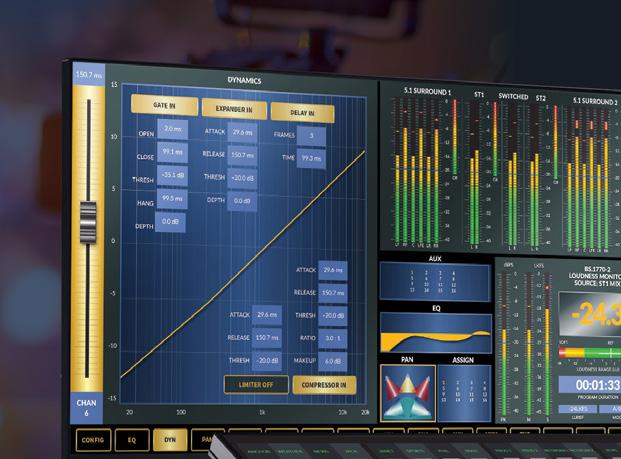











Make quick, precise audio adjustments from anywhere, any time. Complement your news automation system with this virtual mixer.
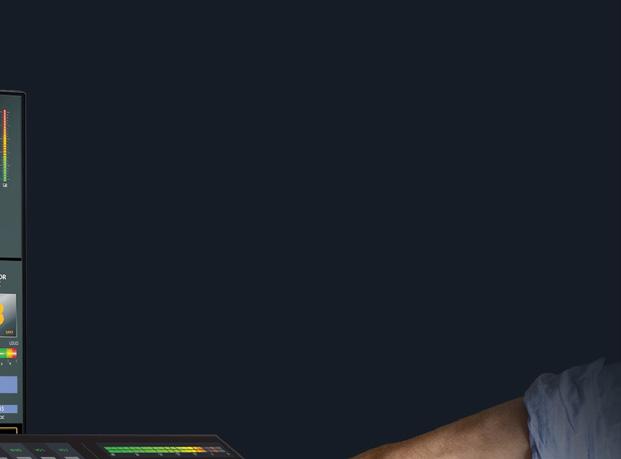







Adjust the occasional audio level with the Virtual Strata mixer as an extension of your production automation system. Mix feeds and manage the entire audio production with all the mix-minus, automixing, control and routing features you need from your touchscreen monitor or tablet. Fits in any broadcast environment as an AES67/SMPTE 2110 compatible, WheatNet-IP audio networked mixer console surface
Connect with your Wheatstone Sales Engineer Call +1 252-638-7000 or email sales@wheatstone.com




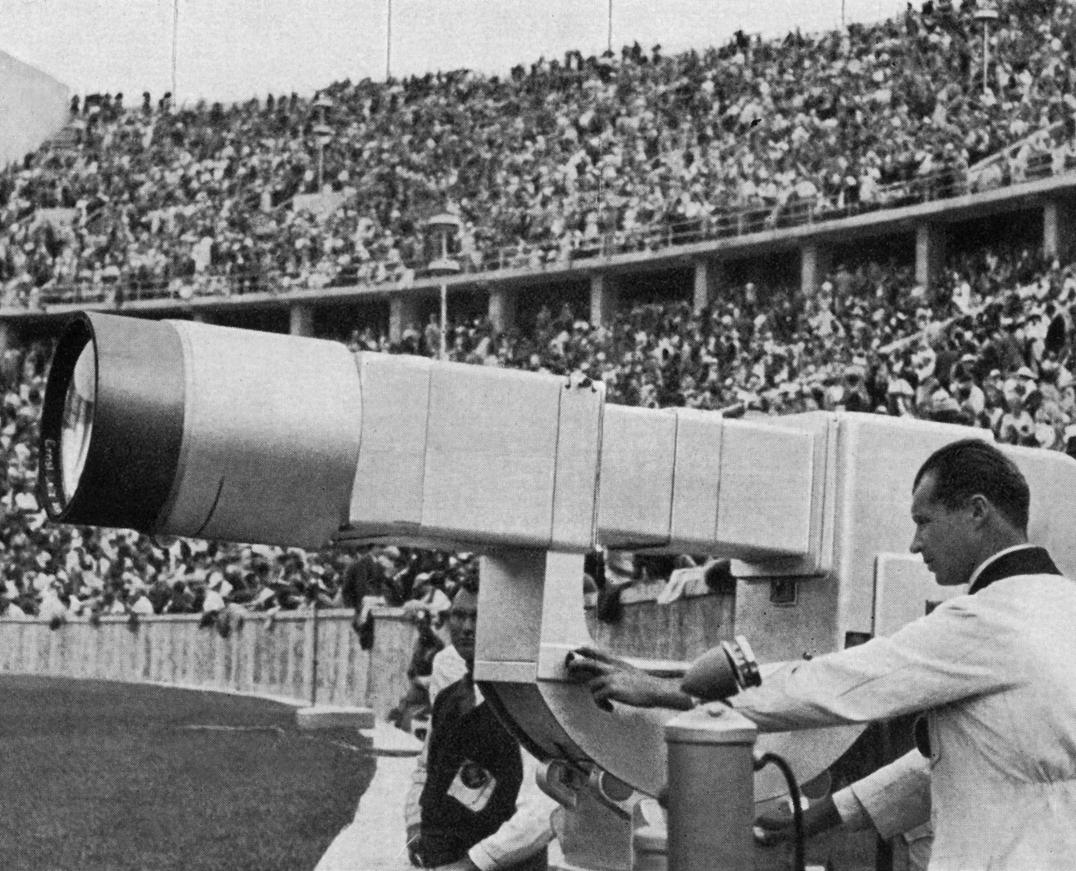
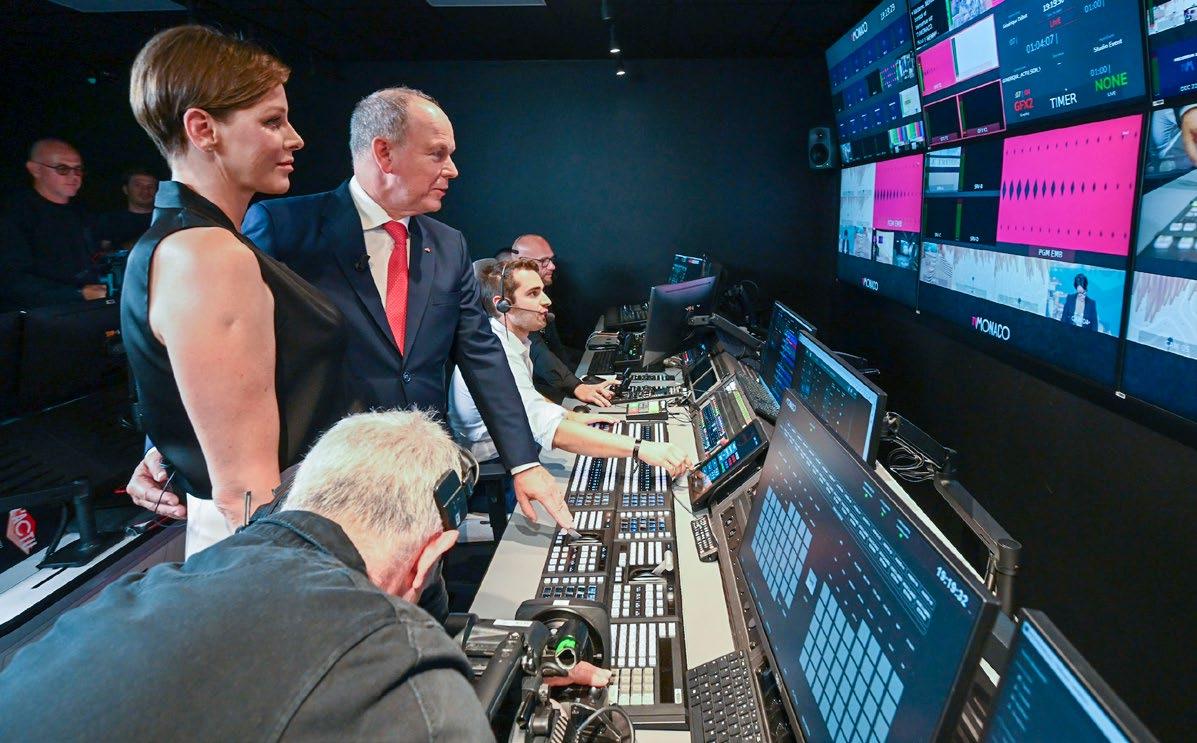

Kevin Hilton
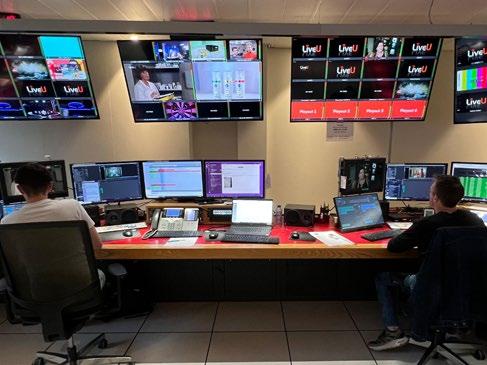

When you mention the word “broadcasting” to a member of the general public, naturally the first thought that comes to mind is “television.” But as last month’s annual ATSC NextGen Broadcast meeting demonstrated, for the advanced broadcasting standard also known as “NextGenTV,” the “TV” part is just one part of the equation.
For years, the “success” of ATSC was measured by touting the number of NextGenTV-enabled TV sets and market deployments. For example, we now know that 10 million such sets have been sold in the U.S. over the past three-and-a-half years and approximately 75% of U.S. households are within reach of a 3.0 signal. That’s the public/consumer face of ATSC 3.0, and while we don’t really know how many of those sets are using an antenna to receive 3.0, the numbers are impressive considering the short time span.
But when you look “under the hood” of 3.0, it becomes apparent that measuring the success of the standard could first come from realizing ROI from non-TV applications. We’ve known about the potential of 3.0 for years to provide enterprise-level datacasting, emergency alerting that goes far beyond the current capabilities, and in particular, more recently, the potential of geopositioning via the Broadcast Positioning System (BPS). And in 2024, with the announcement of services such as ONE Media’s “Broadspan,” we may soon be better able to determine the economic feasibility of 3.0.
And while other areas of the world have been slow or non-responsive when it comes to adopting 3.0, some of the world’s largest countries are recognizing the potential of parts of the 3.0 ecosystem. Brazil, for example, has been testing the ATSC 3.0 physical layer to possibly use it for the over-the-air transmission component of Brazil’s “TV 3.0” broadcast standard, and India is testing over low-power, low-tower topology with a primary goal of using 3.0’s capability for distributing direct-to-mobile services.
Although the headlines out of last month’s gathering revolved around FCC Commissioner Brendan Carr’s suggestion of another spectrum auction (see p. 8)—as well as speculation over when the “Future of TV” task force would release its longawaited report—the organization also unveiled a new logo and mission statement.
ATSC President Madeleine Noland explained:
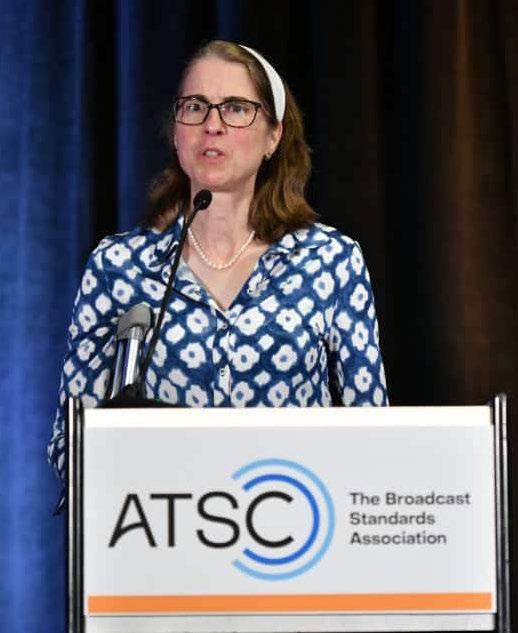
“ATSC has been developing a new brand and a new mission and vision statement that we hope will inspire everyone who values one to many services to new ways of delighting audiences and realizing business goals. This is not a complete rebirth of broadcasting as we know it, but rather it’s an evolution… a modernization of broadcasting for the world today.
“Our mission is to empower the broadcasting ecosystem through innovation and collaboration. And our vision is to enable a more connected world that unlocks the full potential of broadcasting. From conventional television to innovative digital data services, versatile ATSC platforms support a multitude of applications with one clear goal: to empower the broadcasting ecosystem like never before.”
Past ATSC meetings have primarily focused on programming and audience, and while some of this year’s agenda discussed those traditional TV components, much more of the two-day program was devoted to what 3.0 can do beyond the traditional living room TV set. With a new vision statement that better defines its future goals, the ATSC is demonstrating how the diversity of 3.0 will help ensure the future of broadcast technology and perhaps help mitigate (or at least delay) another potential spectrum grab.
Tom Butts Content Director
tom.butts@futurenet.com
Vol. 42 No. 7 | July 2024
FOLLOW US www.tvtech.com twitter.com/tvtechnology
CONTENT
Content Director
Tom Butts, tom.butts@futurenet.com
Content Manager
Terry Scutt, terry.scutt@futurenet.com
Senior Content Producer
George Winslow, george.winslow@futurenet.com
Contributors: Gary Arlen, James Careless, Fred Dawson, Kevin Hilton, Craig Johnston, Bob Kovacs and Mark R. Smith
Production Managers: Heather Tatrow, Nicole Schilling
Art Directors: Cliff Newman, Steven Mumby
ADVERTISING SALES
Managing Vice President of Sales, B2B Tech Adam Goldstein, adam.goldstein@futurenet.com
SUBSCRIBER CUSTOMER SERVICE
To subscribe, change your address, or check on your current account status, go to www.tvtechnology.com and click on About Us, email futureplc@computerfulfillment.com, call 888-266-5828, or write P.O. Box 8692, Lowell, MA 01853.
LICENSING/REPRINTS/PERMISSIONS
TV Technology is available for licensing. Contact the Licensing team to discuss partnership opportunities. Head of Print Licensing Rachel Shaw licensing@futurenet.com
MANAGEMENT
SVP, MD, B2B Amanda Darman-Allen VP, Global Head of Content, B2B Carmel King MD, Content, Broadcast Tech Paul McLane VP, Head of US Sales, B2B Tom Sikes VP, Global Head of Strategy & Ops, B2B Allison Markert VP, Product & Marketing, B2B Scott Lowe Head of Production US & UK Mark Constance Head of Design, B2B Nicole Cobban FUTURE US, INC.
130 West 42nd Street, 7th Floor, New York, NY 10036


Publishing Limited (company number 2008885) is registered in England and Wales. Registered office: Quay House, The Ambury, Bath BA1 1UA. All information contained in this publication is for information only and is, as far as we are aware, correct at the time of going to press. Future cannot accept any responsibility for errors or inaccuracies in such information. You are advised to contact manufacturers and retailers directly with regard to the price of products/services referred to in this publication. Apps and websites mentioned in this publication are not under our control. We are not responsible for their contents or any other changes or updates to them. This magazine is fully independent and not affiliated in any way with the companies mentioned herein.
If you submit material to us, you warrant that you own the material and/or have the necessary rights/permissions to supply the material and you automatically grant Future and its licensees a licence to publish your submission in whole or in part in any/all issues and/or editions of publications, in any format published worldwide and on associated websites, social media channels and associated products. Any material you submit is sent at your own risk and, although every care is taken, neither Future nor its employees, agents,subcontractors or licensees shall be liable for loss or damage. We assume all unsolicited material is for publication unless otherwise stated, and reserve the right to edit, amend, adapt all submissions.
Please Recycle. We are committed to only using magazine paper which is derived from responsibly managed, certified forestry and
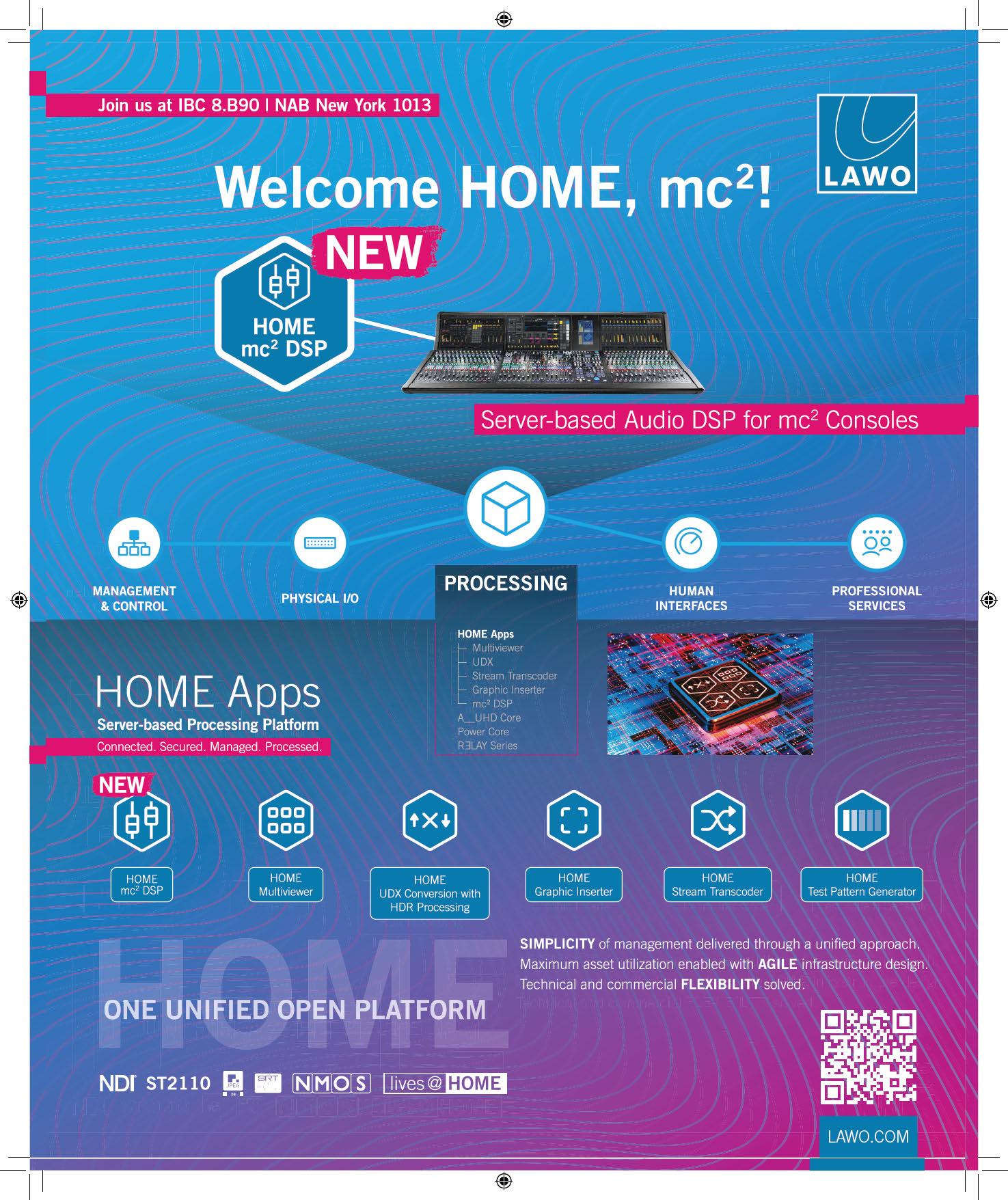
During the annual NextGen Broadcast Conference in Washington D.C. last month, the ATSC honored Dr. SungIk Park of Korea’s Electronics and Telecommunications Research Institute (ETRI) with the organization’s Mark Richer Industry Leadership Medal and presented Ali Dernaika of Hewlett Packard Enterprise (HPE) with the Bernard J. Lechner Outstanding Contributor Award.
Named for the legendary former ATSC president who led the organization for two decades spanning both ATSC 1.0 and ATSC 3.0, the Mark Richer Industry Leadership Medal recognizes an individual or team that demonstrates exemplary leadership in advancing the mission of ATSC and epitomizes the vision, tenacity, and leadership qualities that were the hallmark of his leadership.
“Sung-Ik Park has the vision to understand how to move technology forward,” said ATSC President Madeleine Noland. “He has the tenacity to overcome obstacles in his path. And he has the leadership to build great teams to successfully execute on his plans, furthering the broadcasting ecosystem, and ATSC 3.0 in particular. You may think of Dr. Park as a person tirelessly supporting the ATSC 3.0 Physical Layer proposal in Brazil. Together with his colleagues at ETRI and
CleverLogic, this is a major ongoing effort. But it’s important to understand that his contributions to ATSC span many years and many projects. In addition to the Brazil project, Sung-Ik has been very influential for ATSC’s efforts in the International Telecommunications Union.”
The Bernard J. Lechner Outstanding Contributor Award is bestowed once a year to an individual representative of the ATSC membership whose technical and leadership contributions to ATSC have been invaluable and exemplary. The Lechner Award recognizes the first recipient, the late Bernard Lechner, for his outstanding service to the ATSC. Lechner was the retired Staff Vice President, Advanced Video Systems of RCA Laboratories. His 30year career at RCA covered all aspects of television and display research.
2024 Lechner Award honoree Ali Dernaika serves as Co-Chair of ATSC Specialist Group S43, with his work revolving around broadcast core technologies and
the formulation of Broadcast Core Network standard.
“Broadcast Core Network is a central technology for developing datacasting businesses,” said Noland. “You can think of it like the ‘AirBnB’ of renting spectrum capacity. Broadcasters may have some available bandwidth some of the time—like a room in a house that’s not always in use. And enterprise customers may wish to temporarily use this capacity for sending files, media or other data—like booking a room. Broadcast Core Network is the platform that connects broadcasters who have available spectrum with enterprise customers seeking a cost-effective way to distribute data. But that description is just the tip of the iceberg. With Broadcast Core Network, the world of broadcast collided with the networking world.”

It’s nearly unanimous: A YouTube brand is ranked in four of the top five spots as “must haves” by users responding to the latest Hub Entertainment Research Battle Survey.
The dominance of YouTube brands in this year’s survey marks a major swing to the upside from the May 2023 survey when two-thirds of those using the free YouTube service said that it was a must-have, essentially tied with subscribers of Netflix and PlayStation Plus, and behind readers and Spotify users.
The May 2024 findings, however, reveal a big change. The survey found YouTube Premium is ranked as a musthave source by 75% of users, a fraction of a percent behind Spotify. The rest of the top 5 spots are occupied by YouTube, YouTube TV and YouTube Music.
Among younger people (18- to 35-year-olds), three YouTube brands—YouTube, YouTube Premium and YouTube Music—were considered to be must-haves in their top five, the survey found.
“These results are a reminder that number of subscribers isn’t a proxy for engagement,” said Jon Giegengack, principal at Hub and one of the study authors. “YouTube
Premium has far fewer users than Netflix, for instance. But more of those who use YouTube Premium find it to be indispensable. As the streaming entertainment market matures, keeping existing users is a higher priority than attracting new ones. And ‘must have’ sources are less likely to be canceled.”
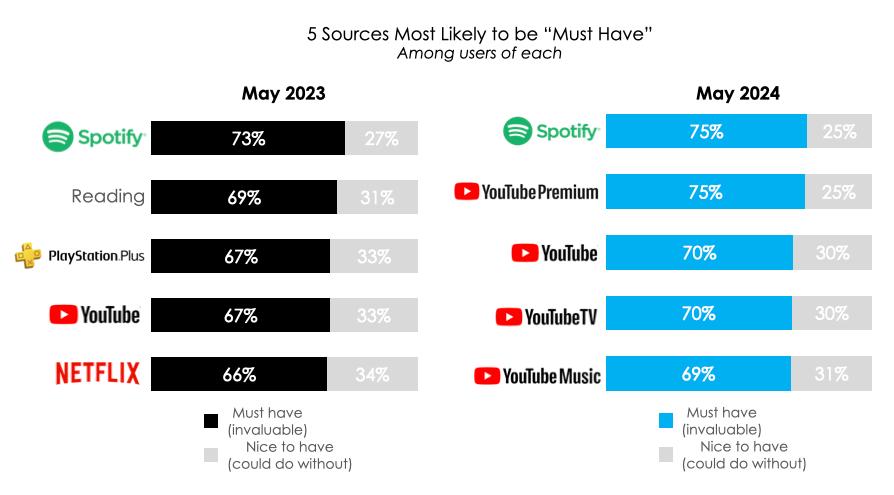

Don’t give up UHF channel assignments without a fight.
Commissioner Brendan Carr suggested a new incentive auction of TV spectrum is coming at the annual gathering of ATSC members in Washington, D.C., in June.
I’m not surprised. In 2019 at a breakfast presentation during the NAB Show, then-FCC Commissioner Michael O’Reilly predicted another voluntary incentive auction would be on the way at some indefinite point in the future.
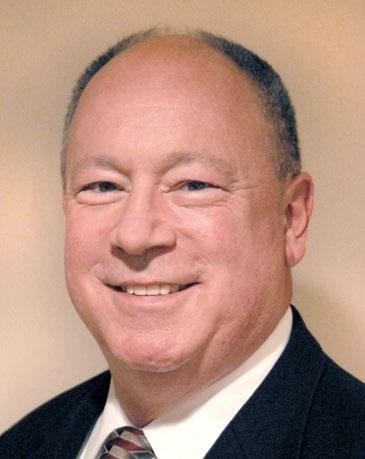
Phil Kurz
While no plans yet are in place for Incentive Auction 2.0, it’s not too hard to see how one will be sold to the industry. First, an auction is a second chance at quick cash for broadcasters not chosen last time. Second, the 3.0 lighthouse strategy has demonstrated NextGen TV’s bandwidth efficiency. So, no harm, no foul taking more spectrum, right? Third, many repacked stations will benefit from a new RF infrastructure thanks to auction proceeds.
However, taking this without a fight seems to be snatching defeat from the jaws of victory.
Fewer TV channels mean less bandwidth for datacasting, a business diversification strategy sure to take on greater importance as cord-cutting continues, threatening the foundation upon which retrans revenue rests. Fewer post-buildout 3.0 sticks also mean fewer to provide the backbone of a future GPS alternative (see Section 4, Subsection h). While a NextGen TV-based Broadcast Positioning System (BPS) offers the government a fast-to-deploy, inexpensive backup, the Feds haven’t even yet decided to evaluate it. Shouldn’t they, before another auction takes place?
For broadcasters looking to cash out and claim auction proceeds, consider this: Incentive Auction 1.0 garnered $10.05 billion for exiting TV broadcasters, but BIA Advisory Services has estimated 3.0 datacasting could generate an additional $10.7 billion in yearly
revenue by 2030. Even if that’s high, how can a one-time auction proceeds payment possibly exceed recurring 3.0 datacasting revenue?
Before the industry accepts another incentive auction, it should lobby Congress to legislate requirements for any bidder.
First, mandate they all offload mass distribution video traffic to the most bandwidth-efficient wireless service available. If that’s 3.0, so be it. If it’s a 5G Broadcast network, fine. A mix? That’s good, too. But one thing it won’t be is a unicast network.
Video accounts for a huge portion of wireless traffic. One-to-many is only a part of the total, so there’s plenty of other video traffic for wireless networks. Besides, the FCC wants to ensure the most efficient use of limited spectrum resources, right?
Second, require bidders to make their cell networks at least as resilient to disasters as TV RF infrastructure. Mandate generators and fuel supplies at each cell tower as an auction condition. After all, how is it in the national
interest to promote a less resilient wireless network at the expense of one that’s more resilient?
Third, bidders should pony up big bucks (tens to hundreds of millions) for a Broadcast RF Vendor Compensation Fund. Payments should fund any TV broadcast chain hardware or software vendor suffering declining business resulting from the FCC closing its Construction Permit window. Remember, the industry lost some—and nearly lost other RF vendors—the last time around. Many other auction requirements surely exist, but at least this is a start.
The propagation characteristics of highband 5G may have run headlong into the economic reality of deploying antennas on every other light pole across America— making UHF spectrum all the more desirable. As that realization has become apparent, broadcasters have been deploying their own new wireless system. It carries nearly as much data as can be carried on a noisy channel and is designed to use new, ever-more efficient data compression schemes as they come along.
The unintended consequence of this efficiency is that competitors will always be able to ask for more UHF spectrum because broadcasters will continue to do more with less for the foreseeable future.
Now is the time to address this head on. Lobby Congress, protect the UHF band from further encroachment, create new competition for wireless networks and earn new revenue to help pay the cost of serving the public with free over-the-air TV. If not now, when? Incentive Auction 3.0?

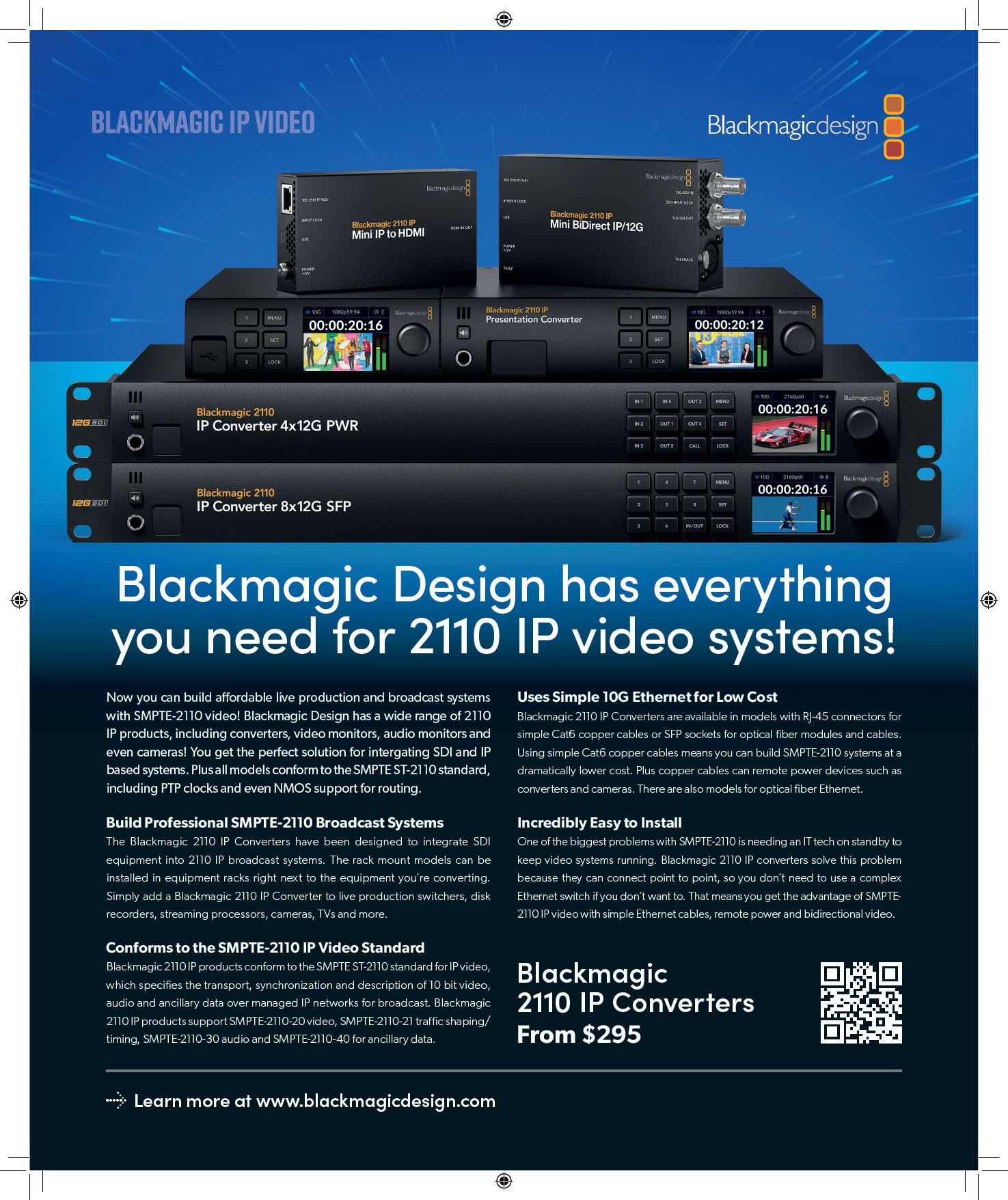
HDR and ST 2110 are among the behind-the-scenes innovations
By Bob Kovacs
Citius, Altius, Fortius has traditionally been the motto for the Olympic Games, Latin words for “Swifter, Higher, Stronger.” In 2021, the motto was officially modified to be Citius, Altius, Fortius – Communiter, meaning “Swifter, Higher, Stronger – Together.”
As we roll up to the 2024 Summer Olympics in Paris, July 26–Aug. 11, NBC, the official U.S. broadcaster for the games, will demonstrate its interpretation of the motto with a broadcast that is swifter, higher and stronger. The network has been working for nearly two years in both Paris and at the NBC Sports hub in Stamford, Conn., to ensure that everything has been pulled together, according to Darryl Jefferson, senior vice president of engineering and technology for NBC Olympics and Sports.
This will be Jefferson’s first games as head of NBC Olympics’ tech operations, succeeding long-time veteran Dave Mazza, who retired in 2022. Jefferson has been with NBC Olympics since 2008, managing Post Production and Asset Management teams and was instrumental in the development of the network’s innovative Highlights Factory/Asset Management System.
“We started design and peer review about 20 months ago, with build, configure and test in our integration facility,” Jefferson said. “We tested video paths, workflows, delivery mechanisms and failure modes all before items shipped out. We ship gear mostly pre-configured, preinstalled, and pre-tested, for both speed of deployment and for peace of mind.”
With a broadcast as complex as the Olympics, with numerous venues and the need to integrate feeds from the primary Olympics video system, the number of moving parts is staggering. Take something like the intercom system—viewers are never aware of it, but it plays a crucial role in coordinating between all the different venues and crews.
“It has indeed been quite a challenge,”

he said. “Our dedicated comms group has especially focused on inter-communication with our large presence in Stamford. Candidly, managing those comms-trunking resources at this size and scale has required rethinking and expanding many of our core resources, and resources that are also sent out at our venues, as well. Part of the challenge of lashing up two cities far apart is seamlessly allowing folks to communicate.”
Moving its system to a new Olympics venue every two years is an incredible challenge, but NBC will ensure viewers will see a seamless broadcast—so seamless that many may not realize that although the action is happening
in Paris, many of the commentators and on-air talent will be in Stamford.
Among many benefits of this Paris-toStamford approach is that the network has less equipment to rip out and relocate—or abandon—after each Olympic broadcast. It seems counter-intuitive that having two such widely separated technical areas and operations is more efficient than having it all in one place, but the reality is that separation increases speed and efficiency.
“The biggest leap is splitting large parts of our team between Paris and Stamford,” Jefferson said. “Transporting large quantities of cameras, effects gear and studios full of equipment all the way home has historically not been financially viable. In some cases, the latency was unacceptable. That split approach allows us to cover more sports with fewer total people traveling than just a few Games ago.”
However, between the time of the old four-year cycle and the new two-year cycle that took effect 30 years ago, the industry has gone through a revolution in connectivity and capability.
“With new tools, robust networks, capacity with cloud infrastructure, and the ability to approach signal transport


differently, there exists a whole host of new options today,” he said.
High-end sports broadcasts are among the first to use emerging technologies, and NBC’s preparation to broadcast more than 5,000 hours of live Olympics coverage from Paris is no exception. Add in the complexity of covering a sporting event spread over several arenas and locations, and it’s like preparing for the Super Bowl… times 10.
Jefferson and his team found there were several new things that had to be handled carefully for this Olympics broadcast, which will be broadcast in 4K/HDR and 5.1.4 immersive audio.
“It may be a tie between getting HDR support everywhere we may need it, and the large cut over to support IP in many places,” he said. “Although we’ve had important experience with both, there exist so many devices, solutions, vendors and third parties that do not support wide color gamut today, or equipment through which color information doesn’t survive.
“Testing every graphics device or element of delivery to ensure all is consistent has required a decent amount of patience,” Jefferson added. “In a similar way, building a resilient and nimble IP system has also been a process.”
One might assume the native Olympic video infrastructure would be 4K/UHD. However, Jefferson said that is not the case. “Our format is 1080p HDR [HLG] at 50Hz,” he said. “We are thrilled that this mezzanine format will be supported at every venue and site.”
As you might imagine, a very large number of vendors provide the gear to make the broadcasts work. In addition to the gear that NBC brings to the Olympics, the Olympics organization has its own broadcast service that works behind the scenes and supports all national broadcasters. The Olympics Broadcast Services (OBS) positions all the cameras at the events and provides feeds and much more to the dozens of national broadcasters, including NBC.
“We have worked with OBS on their camera positions and event orchestration,” Jefferson said. “We also worked with Sony on switchers, cameras and monitors, with EVS on replay devices and IP orchestration, with Grass Valley/Cisco on core/IP routing, Avid on editing and asset management, Chyron on graphics, Riedel on SimplyLive, and so many more.”
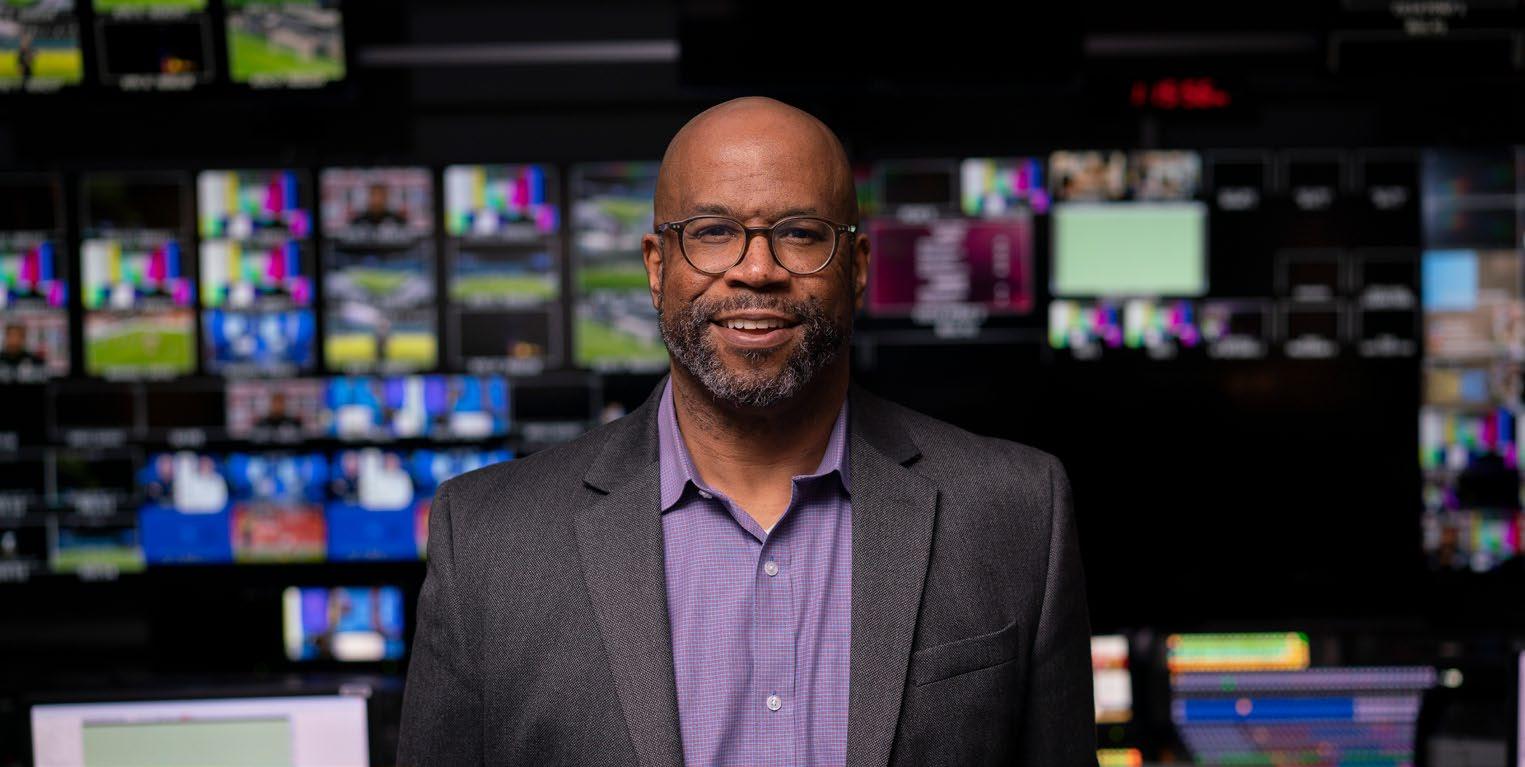
One of the most basic decisions assembling a system of this size is where to use the SMPTE ST 2110 IP video standard and where to use the older SMPTE SDI standard. Where and how these two are used makes a big difference in how signals are routed, and routing signals at the Olympics is one of the core tasks.
“We have a healthy mixture of both, but are about 60% ST 2110 handoff, venue and core orchestration,” Jefferson said. “In some cases, we support both formats within a Tech Center, or gateway translation to convert one to the other. Fortunately, we have spent the last few Games [since Tokyo] making the transition over time, and certainly learning all the lessons.”
Jefferson detailed how the NBC Olympics team took IP/SDI integration step-bystep in order to maximize compatibility and minimize conflicts. “First [we used] a lifeboat router, larger core switches, and a split router in support of both HDR/SDR,” he said. Now [we have] one single format, signal redundancy and a streamlined approach. Each of these steps has been critical in uncovering the complexity and flexibility of IP.”
In addition to SDI and ST 2110, NBC is also using some of NewTek’s semi-
“The goal of all this technology is to bring more elements of storytelling around each athlete’s journey.”
DARRYL JEFFERSON, NBC OLYMPICS & SPORTS
proprietary Network Device Interface (NDI) standard. “We are using NDI in some areas, specifically NDI v6, with support of HDR and enhanced audio,” Jefferson said.
Jefferson promised a host of new features for NBC’s broadcast of the Summer Olympics. A lot of it sounds technical, but the goal is to give the viewer insight that wasn’t previously possible.
“We have a whole trove of new technology, some of which is well behind the camera [ST 2110 and Dante, HDR and ATMOS everywhere], new encoding mezzanine formats, and also a good deal of enhancements to bring viewers further behind the scenes,” he said. “Backstage cameras, audio from coaches, cameras in the stands with families, even biometrics on family and coaches. The goal of all this technology is to bring more elements of storytelling around each athlete’s journey.”
The Olympics are more than just another big sporting event. It is an international cultural experience, a massive stage on which scandals are magnified and missteps are ridiculed. Bad guys have been known to use this hyper-focus of media to perpetrate big crimes—and viewers expect that such coverage will be captured with all the depth and clarity of the sports events themselves.
However, the winning part of the broadcast is the part that tells the small stories: The struggles, burdens, perseverance and stamina of the individuals who participate. When the camera shows the sweat on a face and fierceness in the eyes, it is giving you what you can only get from an experienced and well-equipped television crew.
This summer, NBC stands poised to deliver its best Olympics yet. l

The Olympics are more than just a sporting event—they are a showcase of human stories that inspire and captivate us. As media technology evolves, so does our ability to share these stories with audiences around the world. Artificial Intelligence is one of the technologies that is transforming how we experience sports media, especially at the Olympic level. AI can help us tell the story of each game or match, the historical significance of the event, and the ways we can keep fans engaged even after the event is over.
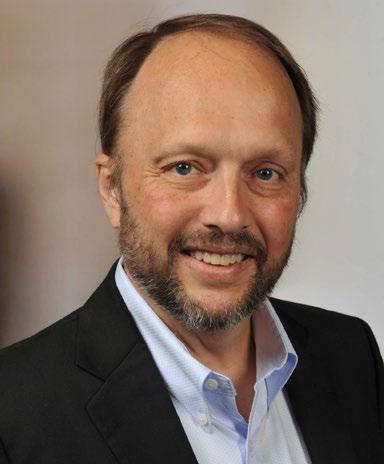
used by OBS at the 2018 games (PyeongChang) where it was used for content tagging, recommendations, and language translation. It was also used in several other areas of the games, such as time recording systems and biometric analysis of athlete performance.
According to OBS, the 2024 Games will be the most advanced yet in terms of technology with the two week event. The games will be fully produced natively in UHD HDR, along with immersive 5.1.4 sound using more than 1,000 camera systems and 3,600 microphones.
group expands to more than 8,000 people from more than 110 different countries during the games itself. This is an incredible organizational and technological achievement that only gets more sophisticated with each Games.
Of course, AI is also playing a bigger role at this scale of event production and distribution. AI will be used for autoclipping of content and descriptive metadata tagging. The technology will be used to provide transcriptions and translations of interviews for journalists and to help them find content. It will also be used to provide captions/subtitles in real time for live coverage. Data gathered by various biometric and other sensors deployed through the event will be processed and provide unprecedented information to viewers, often in real time.
Ever since the modern Olympics began in 1896 (Athens), people have been fascinated by the games. And with each new era, the latest technological innovations were used to bring the games to viewers across the globe. The first coverage of the event was through newsreels in theaters. Radio started with live coverage in 1924 (Paris), 100 years ago. You might be surprised to learn that television coverage began in 1936 (Berlin), with a kind of closed-circuit system that showed the games in public places near the stadium. It wasn’t until the1960 games (Rome) that the broadcast reached other countries.
The Olympic Broadcasting Services (OBS) was established in 2001 with the core mission to act as the host broadcaster for the games, delivering the sights and sounds to viewers all over the world. It started fulfilling that mission with the 2008 games (Beijing) and has been responsible for the main infrastructure and media related services for every Olympics since. OBS has been remarkable in its constant innovation with each event, maintaining quality and reliability during a time when media technology has changed a lot.
AI is part of this change. Depending on which specific AI technology we are talking about, we can say that AI was first
OBS will produce more than 11,000 hours of content and process more than 3,000 UHD and HD feeds within the International Broadcast Center. More than 80 different distribution feeds will be managed. The IBC facility covers about 40,000 square meters, a 13% reduction from the 2020 Tokyo Games held in 2020. A total of 36 different venue broadcast compounds will be supported.
Amazingly, OBS does this with only about 160 full-time employees. The core
Perhaps most impressively, it will be used to create automated highlights for potential distribution to several different platforms, including those using vertical formats. These will be generated on demand at any level of interest from a county to a sport to an individual athlete and can be tailored to mood or many other factors that producers may want to consider.
AI technologies of all kinds will continue to play a role in allowing media companies to produce major live events with richer and more sophisticated viewing experiences. Even in the areas where AI is already playing a role, it is easy to see the potential for an even greater role. For example, clips and highlights packages could be generated for smaller

audiences or even an individual viewer in a reasonably cost-effective way.
These highlight-generation technologies could include even more relevant stats and help producers and viewers find even more interesting “gems” hidden in the content. It can also help production teams fill time in between gaps in the action with some realtime context setting, or information about the sport, scores or other key story lines. It can bring real-time information with context directly to presenters and allow them to provide even more texture for audiences.
It can also help production crews keep an eye on what’s happening outside the venue and have a more 360-degree view of the “story of the games.” Audiences always want more and we’re reaching the limits of what’s feasible for a human production crew to do, so working AI into production and creative workflows will be crucial to bring better experiences. It will bring otherwise hidden stories to those who want to see them. AI is unlikely to ever be used to alter the “reality” a fan sees; instead it should serve as an enabling function to enhance our production of the content.
Fear of the potential impact of malintended generative AI creating fake or distorted content is an important concern that is being taken seriously by the IOC (International Olympic Committee), OBS, and broadcasters around the world. OBS has been explicit in its commitment to not tampering with the video.
One technology I would anticipate playing a role in coming games in this regard is C2PA (Coalition for Content Provenance and Authenticity), an open technical standard providing publishers, creators, and consumers the ability to trace the origin of different types of media. This will be critical in many areas beyond sport.
We can start thinking now about how AI will help with the story between the games. It might not be so obvious, but 17 days of competition isn’t enough to tell the lifetime story of how an athlete got there. When the flame goes out, preparation for the next games begins right away. AI tools that are looking beyond the content broadcasters generate and into social platforms and the
broader “conversation” can help audiences experience the whole journey to the games and beyond.
The legacy for competitors, for cities, for fans who were present at these epic moments and watched on TV far away can be joined up using the careful application of AI to continue to activate fans throughout the cycle and maintain interest.
At its core, the Olympic games are a human event—an AI cannot compete in the games and can never tell the powerful stories in a way that will bond in a powerful, emotional way with viewers. AI’s roles are becoming clearer, however. In addition to providing capability for increased scale and sophistication, it is time to see AI as a technology to bring more of the “truth” to viewers. AI can assist us in bringing out powerful stories by helping us find and present more relevant and informational content than ever. l
John Footen is a managing director who leads Deloitte Consulting LLP’s media technology and operations practice. He can be reached at usmediamatrix@deloitte.com

Monaco’s Prince Albert II and Princess Charlene at the inauguration of TVMonaco, which uses Riedels Artist intercom system and a suite of SmartPanels, along with the Bolero wireless intercom system, to ensure seamless communication across its broadcast operations.
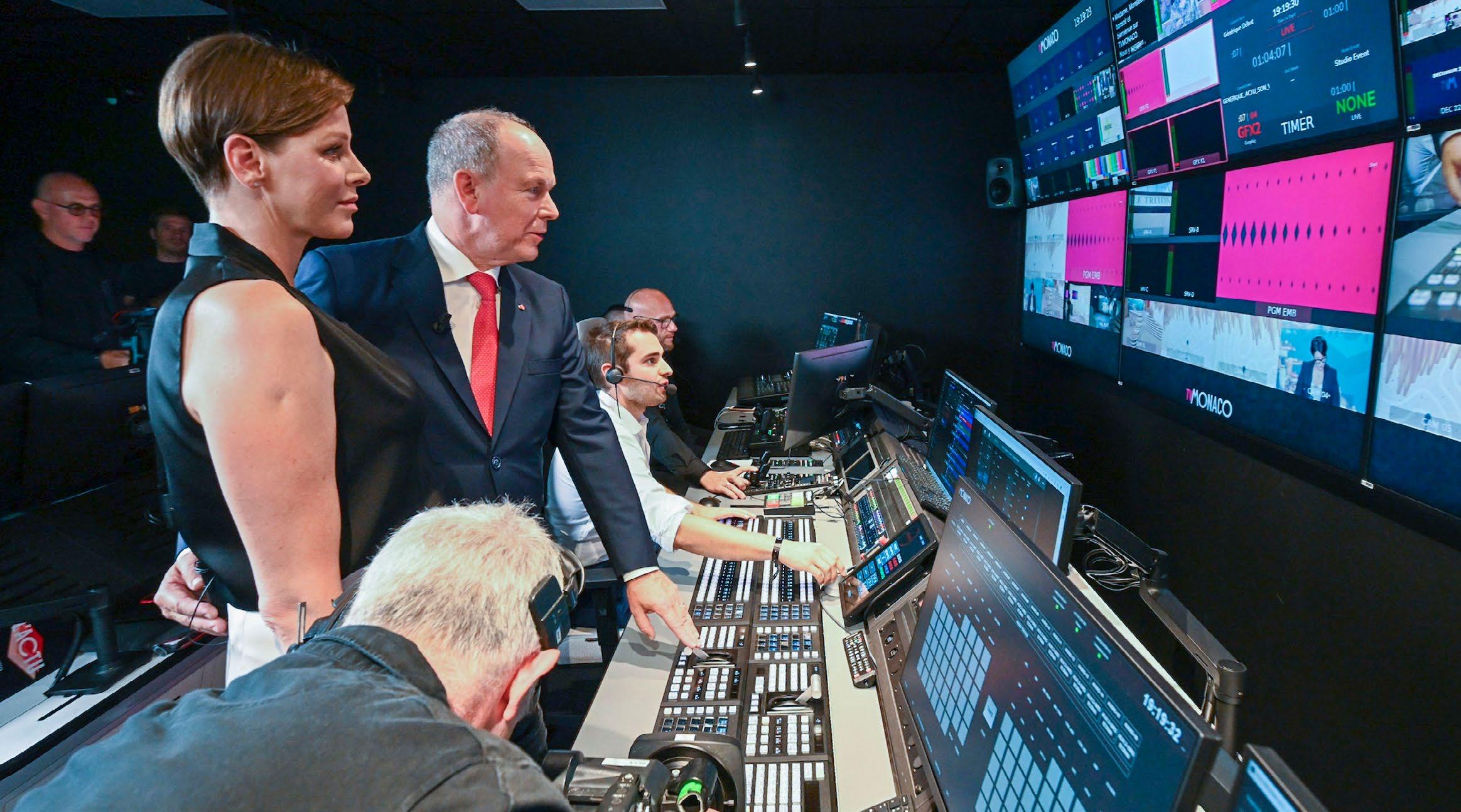
By Kevin Hilton
Broadcasting is all about communicating to and with the viewing audience. A big part of making this happen is the ability for production teams, technical crew and on-air talent to communicate with each other. Which is why intercom has always been a key technology, albeit one with fairly humble beginnings. But from relatively simple systems for studio communications, with facilities to talk to incoming sources, it has grown into both a continually developing technical area and a substantial business sector.
Part of this can be attributed to the expanding scale of TV production, not just bigger and more elaborate shows but also the ever growing use of remote access through
IP networks and the cloud. This has seen REMI (REMote Integration) become a major consideration for intercom installations, although most manufacturers regard it as something that is already well-established in live production.
The difference today, says Dave MacKinnon, recently appointed vice president of product management at ClearCom, is that whereas such a set-up would have been “very well planned out” 10 years ago, broadcasters are now working on a more “run and gun” basis.
“More productions are being done by either one person or a small production team,” explains MacKinnon, who came to Clear-Com after a career that began with the federal government and continued with
12 years at NBCUniversal. “And because of increased bandwidth and 5G, the production center doesn’t have to be in the city the show is coming out of. In the last few years the economics of broadcasting have changed dramatically, with many broadcasters wanting to spin up FAST channels to extend the value of what they are doing.”
As part of this, MacKinnon adds, “flexibility and interoperability” are the two main features broadcasters expect from modern intercom systems. Both these criteria are highlighted by John Hooper, president of Eartec, which produces a range of wireless headsets that can be connected to wired intercoms using the company’s digital interface module.
Eartec’s “plug and play solution includes software to balance the signals of the existing wired intercom and Eartec’s full
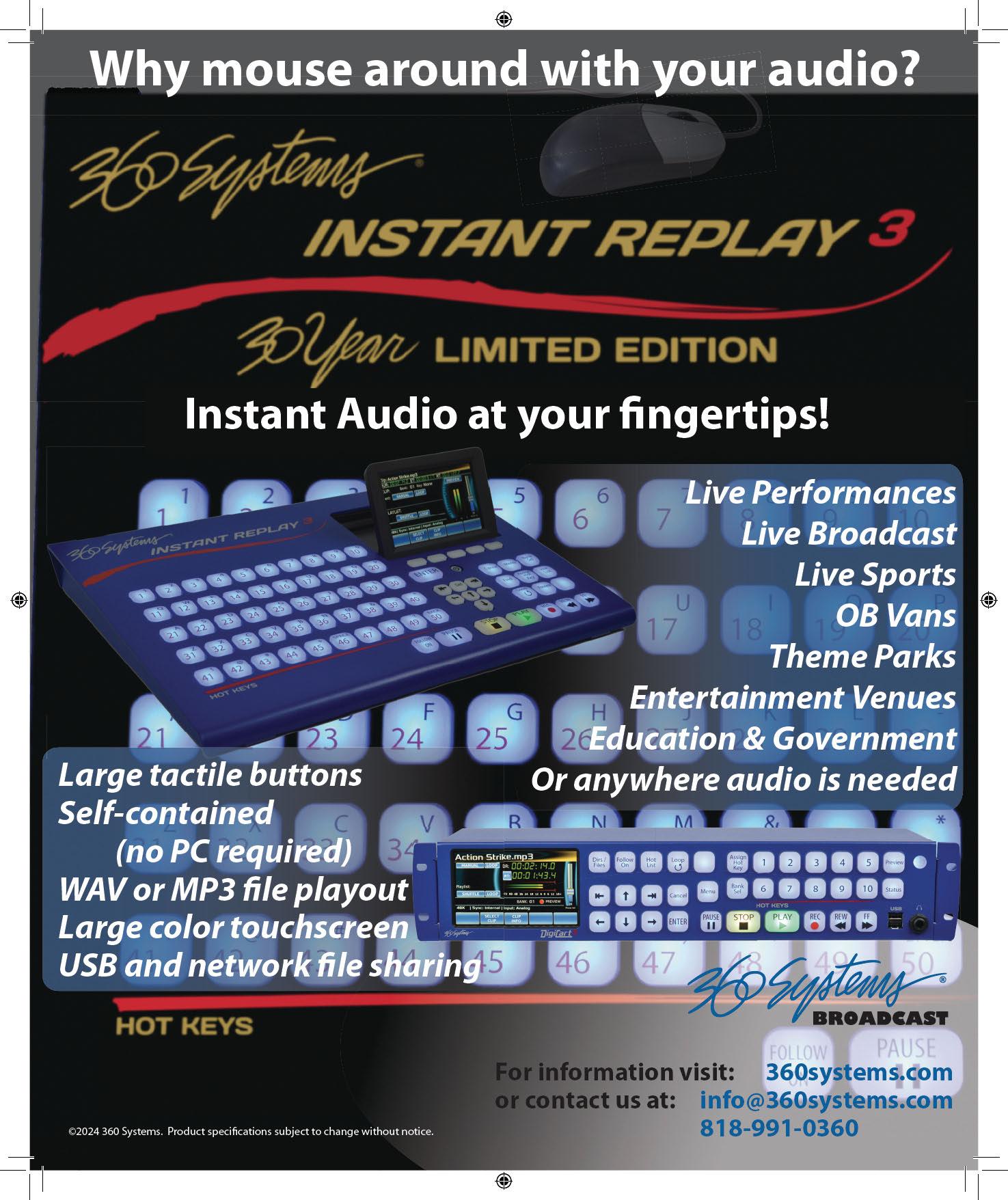
duplex wireless transceivers to create a seamless audio link,” Hooper says. “We’re also seeing a growth in demand for long-range communication and offer [Eartec’s] Global Connect system for wireless communication over IP. This is linked to a computer or even a smartphone and allows mobile wireless users to communicate in full duplex through the internet.”
Eartec recently announced the availability of its new UltraLITE PRO16, a full duplex wireless headset aimed at larger crew sizes.
Rick Seegull, senior vice president of technology and business development at Riedel Communications, adds scalability and reliability to the list of requirements along with flexibility and interoperability. “Of course, there is a major IP component to provide for these features and most are converging to a SMPTE ST 2110-based system so they can easily share resources and sources—for everything, not just intercom— without creating technology islands,” he says.
REMI workflows have been at the forefront of broadcaster’s needs in live location work for several years, Seegull adds.
“This has escalated exponentially since 2020 and now become a standard component for live events, as is At-Home production allowing operators not only to be in the broadcast control room as opposed to on-site but now even being at home whenever the need arises,” he says. “Scalable intercom systems over WAN via VoIP [voice over IP] connectivity or even uncompressed, extreme low latency connections with panels linked anywhere in the world, which allows operators to use the same components they would in the broadcast truck at the venue only back at the main control room or even at home.”
As for the cloud, Seegull comments that it is “definitely being discussed” and used more when it comes to intercoms. This growing interest in virtualized and de-centralized hosting for intercom operations is confirmed by Martin Dyster, vice president of business development at Telos Alliance, which has been a leading proponent of cloud-based communications in recent years.
“We’ve seen a lot of growth and increased interest in this area,” he says. “It’s not necessarily because people are getting into cloud production per se or building entire systems around cloud-based audio and video technology, although those customers exist.
“People recognize the benefits of a virtualized comms system in being ablt to deploy an intercom panel at the drop of a hat to anybody anywhere in the world.”
MARTIN DYSTER, TELOS ALLIANCE
People recognize the benefits of a virtualized comms system in being able to deploy an intercom panel at the drop of a hat to anybody anywhere in the world without the overhead of boxing up a piece of hardware, shipping it round it world and relying on someone to hook it up remotely.”
Telos has “worked closely” with the Media and Entertainment team at AWS to determine “best practices” for larger cloud workflows, according to Dyster. “We’ve also worked with technology partners to get over some of the hurdles of moving multicasts between elastic cloud computing instances [a virtual server or computing environment], which, up until now, has been very difficult to do. The partnership with AWS is very positive and they chose us as the comms partner for its delivery of the NAB Show LIVE broadcasts.”
As Michael Brown, business development manager at RTS, observes, one of the first questions asked when people discuss the cloud is: “Whose cloud?” The options are, he says, hardware on-premises or bringing in a third party to oversee the connections
setup. “Other questions that must be answered include “who is responsible for reliable connectivity and who is liable if there are missed commercial inserts when an automated update to another network occurs?’” he muses. “As well as answering these questions, the technology must be proven before a totally cloud-based comms systems is deployed on a high profile, high value production.”
Brown envisions a hybrid design, with a hardware backbone and cloud connectivity “as an adjunct and secondary usage for noncritical communications.”
Gary Rosen, vice president of global sales for wireless intercom developer Pliant Technologies, calls cloud-based intercom products “a great enhancement to an existing infrastructure” but is not convinced it will become the dominant technology for communications, at least in the short-term. “With so many factors needed to make cloud devices work external to the venue, and given the reliability of on-site systems, I don’t believe current systems will be replaced with cloud-based intercom in the near future.”
Options for cloud operations, Rosen adds, include dedicated and hosted servers, which are either in-house or provided by the likes of AWS and Google. AEQ has taken a different approach to most broadcast manufacturers by offering a dedicated cloud service that was created for the company’s systems.
“We manage it and is our own cloud, providing support to our intercom systems with full back-up and no other material on it,” explains sales director Gustavo Robles. “The cloud is very popular because it offers the possibility to interconnect remote locations in a very easy way. But there are still big projects for big customers that demand a traditional, robust, mega-redundant central matrix with dedicated hardware.”
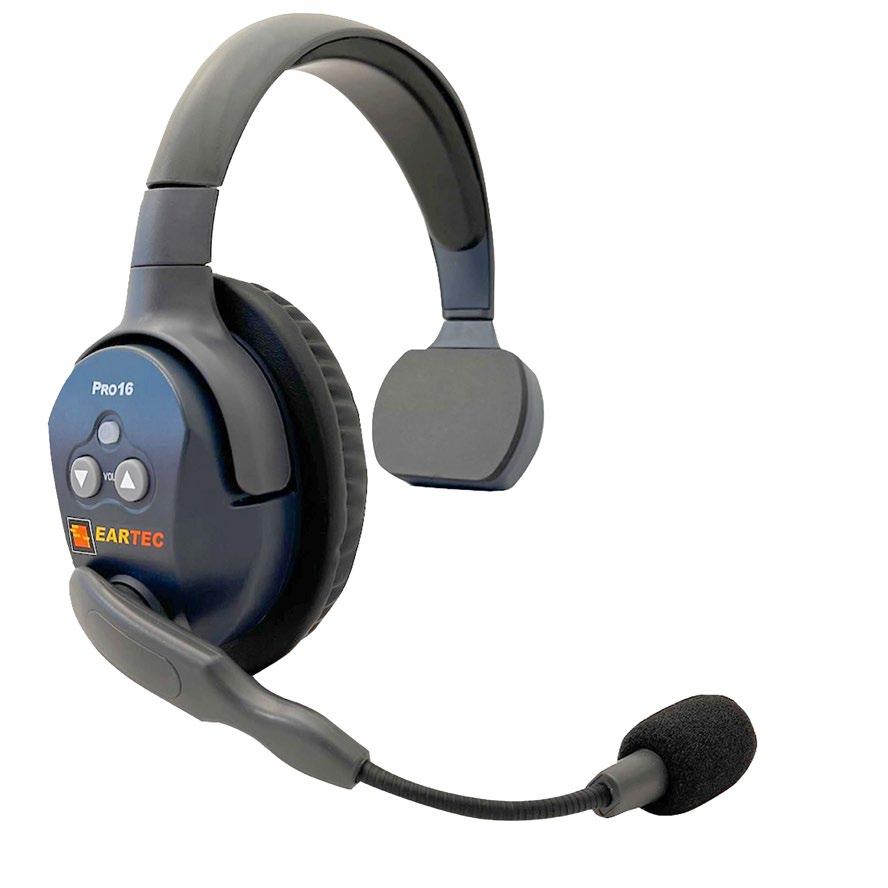
Eartec’s new UltraLITE-PRO16 series headsets
Despite this, Robles acknowledges, requirements are changing, with users deploying what suits the productions, including utilizing smartphones or wearables as wireless beltpacks. The shifting nature of intercom is also shown by Riedel connecting analog microphones to a Bolero wireless intercom beltpack for interview work; and Telos’s prototype combined comms and commentary software panel, which can be controlled either by a touch screen or a hardware box such as the new Elgato Stream Deck Neo.
Which shows that in many ways broadcast intercom is the same as it has always been but is also evolving as new technologies appear to meet broadcaster’s needs. l
Technology, expertise and viewer expectations continue to push audio for live sports
The fidelity and quality of live programing has certainly improved over the last couple of decades; however, inconsistencies exist between events and broadcasters. Through the efforts of many sound designers and mixers, sonically boring sports such as baseball and football have been transformed into consistent aural master pieces. Fox Sports audio mixer Fred Aldous changed the sound of football with the application of wireless microphones on the players, which is only growing in scope and popularity.
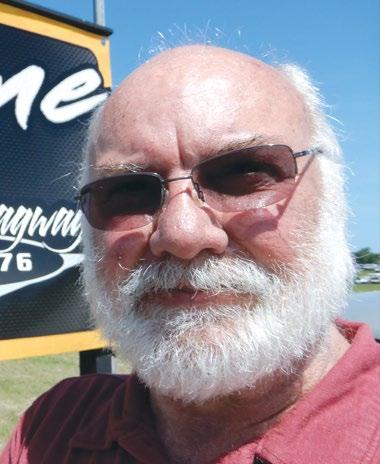
My proposal for wireless microphones in the bases at the 1996 Summer Olympics was shut down by the Cuban delegation fearing that the athletes could communicate to the outside world through my base microphone. Enough cannot be said about Joe Carpenter, audio engineer at Fox Sports, and his impact on baseball sound. He has put wireless microphones in all the bases plus on the homeplate umpire for years.
There’s no doubt that the power of
persuasion from John Madden and the Fox production staff swayed the powers at the National Football League to recognize that this is what the public and viewers want. Clearly gaming sound, particularly on John Madden’s Football video game opened the ears of the consumer who began to ask, “Why can’t I hear that on TV?” Well, you can.
Wireless microphones on just about everybody now has piqued viewers’ interest and increased viewership for the struggling United Football League (UFL).
I commented in a previous article that I thought sound coverage of the FIFA World Cup had evolved to the best ever. This was
We are beyond the basics, and once upon a time, sonically deficient audio coverage was acceptable, but not anymore.


basically accomplished with super-fast computing and some very clever algorithms assisting the mix. However, recently I watched/listened to the international production of UEFA Champions League football (soccer) finals between Dortmund and Real Madrid, and to politely state—it sounded very average and boring. I don’t understand—virtually every sport has upped the game with pictures and sound except soccer.
Basic audio-follow-video was absent, when on multiple occasions I saw handheld cameras with no “close perspective” sound. Basic audio-follow-video is nothing new and was used as far back as 40 years ago where certain microphones, such as microphones on handheld cameras, were controlled by the switching of the camera. Audio-followvideo — basic sound for football/soccer has to include all corner kicks—no exception. Once again, the microphone is only a few feet from the corner and a basic camera switch would never miss a corner kick sound.
We are beyond the basics and once upon a time, sonically deficient audio coverage in sports was acceptable, but not anymore.
SOME IMMEDIATE IMPROVEMENTS
I have expressed my opinion about AI and super computers completely taking over a
live news or sports production. I still have faith in my prophecy but believe there are some immediate improvements that can be achieved with audio and the general production with AI supercomputing.
For example, Lawo’s HOME app platform with its use in the Rugby World Cup, has proven itself able to control the natural field effects. But one level further is available where you can automate the effects portion of the mix with subtle augmentation of field sounds. This powerful and disruptive technology has been developed by the English company SalsaSound and their MixAiR technology. AI can not only execute simple intelligent audio follow, but it can easily improve speech intelligibility through filtering and sampling.
With the 2024 Summer Olympics coming up, I would expect the sound to be significantly better than the Tokyo 2020 Summer Olympics just because the spectators are back. But with immersive sound it is easy to bury the sports effect with too much atmosphere and ambiance. My hope is that they are advancing their microphone coverage using some innovative sound technique like I have outlined in my book “Immersive Sound Production, a Practical Guide.”
High-quality audio production has trickled
down from the production of large events like the Olympics, National Football League and Major League Baseball to where quality production of audio and video is common at all events, from bowling to darts. Take a listen to ESPN’s college softball coverage.
Cinematic sound is not hard—just hard work. Grow with the technology. There is an abundance of affordable sound enhancements that, with digital mixing consoles and audio plug-ins, can help dial in and create your sound. Learn. Last year I went to a Mix Magazine-sponsored event in Nashville about immersive sound and there were more than 100 people who were interested in immersive sound for music production as well as broadcast. The next generation of sound designers must diversify their skills, be persistent and be open minded about how to best entertain their audience. l
Dennis Baxter has contributed to hundreds of live events including sound design for nine Olympic Games. He has earned multiple Emmy Awards and is the author of “A Practical Guide to Television Sound Engineering” and “Immersive Sound Production – A Practical Guide on Focal Press.”
He can be reached at dbaxter@dennisbaxtersound. com or at dennisbaxtersound.com.
Iattended several sessions at the 2024 NAB Broadcast Engineering and IT Conference (BEIT). Many of the presentations were about the signals modulating the RF, focusing on ATSC 3.0 and ATSC 3.0 applications rather than the generation and transmission of RF.
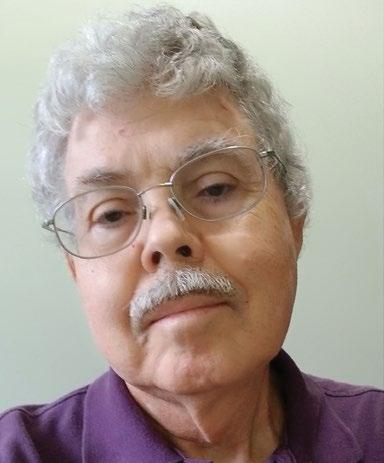
We’ve seen ATSC 3.0 can do more than provide video and audio to TV sets. As I’ve said before, the transition to ATSC 3.0 depends on the availability of devices to receive ATSC 3.0. Demand for these ancillary services
could provide an incentive for broadcasters to switch to ATSC 3.0 and for devices to include ATSC 3.0 capability.
One service that is receiving attention is precision navigation and timing (PNT), and how broadcast transmission can support it. Judah Levine, NIST Fellow, Time and Frequency Division, National Institute of Standards and Technology, showed how unmodified broadcast TV signals could be used to
provide precision time and frequency in “Transmitting Time and Frequency Data by Using Broadcast TV Signals Observed in Common-View.”
In the Common-View system, the transmitter is not modified but the receive time of a known pattern in the signal (i.e. bootstrap in ATSC 3.0) is compared with a local clock at two or more receivers to determine the transmitted time and frequency of the signal. Propagation delay and multipath will introduce some errors but the error can be calculated.
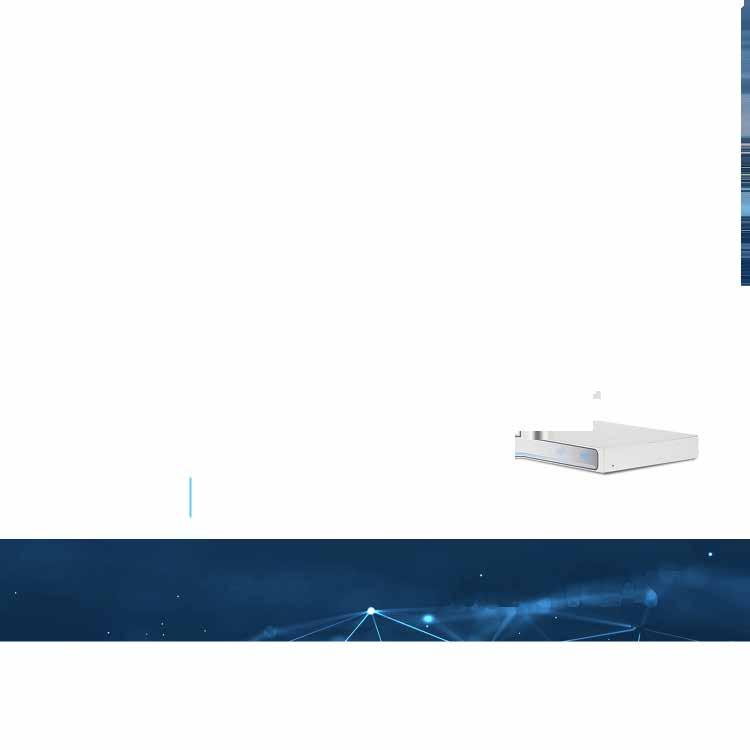

The method is similar to one used in the early days of color TV when the 3.579 MHz color subcarrier frequency of network affiliates was locked to that of the network. This technique stopped working when broadcasters started using digital frame synchronizers and with their own local reference.
There were several presentations on the Broadcast Positioning Service. The presentations reiterated the need for a backup for GPS and outlined the progress being made in developing and testing BPS in different locations. BPS is one of the systems for GPS backup under consideration. Comments from experts at the sessions indicated BPS was at or near the top of the list.
One presentation, “ATSC 3.0 Broadcast Positioning System (BPS) Mesh Network” by Vladimir Anishchenko, president and CTO at Avateq, and Mark Corl, senior vice president, Emergent Technology Development at Triveni Digital, showed how multiple transmitters could form a mesh network, with “leader” transmitters having traceable time references and “followers” that would compare their clocks with those from neighboring transmitters, including the leader transmitters. The paper in the NAB BEIT Proceedings has detailed drawings and tables showing how this works. Fig. 1 on p. 22 shows a simplified diagram from a Humber College presentation.
The BEIT presentation “ATSC 3.0 and Wireless Emergency Alerting – A Great
Match” by Fred Engel at PBS North Carolina and Chris Lamb at Device Solutions showed how ATSC 3.0 can provide alerts when the cellular system is down, as was the case during the Maui fires. It is easier to protect a high-power, high-tower transmission site than cell sites distributed in the area experiencing the disaster.
The other advantage, which utilizes the paging receivers developed by Device Solutions, is reduced latency. Conventional paging systems using digital radios employed by public safety agencies can have minutes of delay compared to seconds with systems using ATSC 3.0. Google “NextGen TV” and “PBS North Carolina” to view a YouTube video that shows how ATSC 3.0 is used to deliver emergency dispatch information over a large area.
While there was interest in 5G Broadcast transmission and there were products on display, I heard more discussions about how ATSC 3.0 and 5G (both 5G Broadcast and New Radio) could complement each other. I did not see any papers devoted to 5G Broadcast, but there were presentations showing how 5G (both 5G Broadcast and 5G New Radio) and ATSC 3.0 could work together.
In her presentation “How IP-based Broadcast Meets 5G for Resilient and Sustainable Media Distribution,” Emily Dubs, head of technology at the DVB Project,
explained how the DVB-I standard works with existing broadcast standards, not only DVB-T2 but ATSC 3.0 and others, to give devices multiple options for receiving content via broadcast if available and if not, ways to obtain the content over an IP connection (wired or wireless).
While there was interest in 5G Broadcast transmission and there were products on display, I heard more discussions about how ATSC 3.0 and 5G (both 5G Broadcast and New Radio) could complement each other.
The DVB-I service discovery can show receivers the optimum path for receiving program content. As part of the explanation, Dubs also discussed the challenges broadcasters face getting their content to mobile devices and how broadcasters and mobile network operators can help each other with distribution. More

Fig. 1: This diagram shows how multiple transmitters transmitting ATSC 3.0 could form a mesh network for Broadcast Positioning Service.
information is available in the presentation and at https://dvb-i.tv/.
One of the most interesting technical presentations was from Louis Libin and Mike Simon from ONE Media Technologies showing how 5G frames could be mapped into ATSC 3.0 signals to allow a broadcaster to deliver data in both an ATSC 3.0 format and a 5G compatible format and take advantage of receive device power saving options available in both.
Even though the ATSC 3.0 standard is extremely flexible, there are differences with 3GPP 5G standards that make it difficult to add time-multiplexed 3GPP 5G frames. Libin and Simon explained how an extension to the ATSC 3.0 standard and update to 5G New Radio (perhaps in 3GPP Release 20) could allow a station to transmit a signal with portions available on both ATSC 3.0 receivers and 5G devices.
The presentation, “The Convergence Opportunity for ATSC 3.0 and 5G NR Multicast Broadcast Service” is available in the Proceedings and with a password (available from ONE Media) at https://onemediallc.com/libinsimon/ I did catch a presentation that focused on transmitting RF, “An Innovative In-Service Antenna Monitoring System to Protect Your


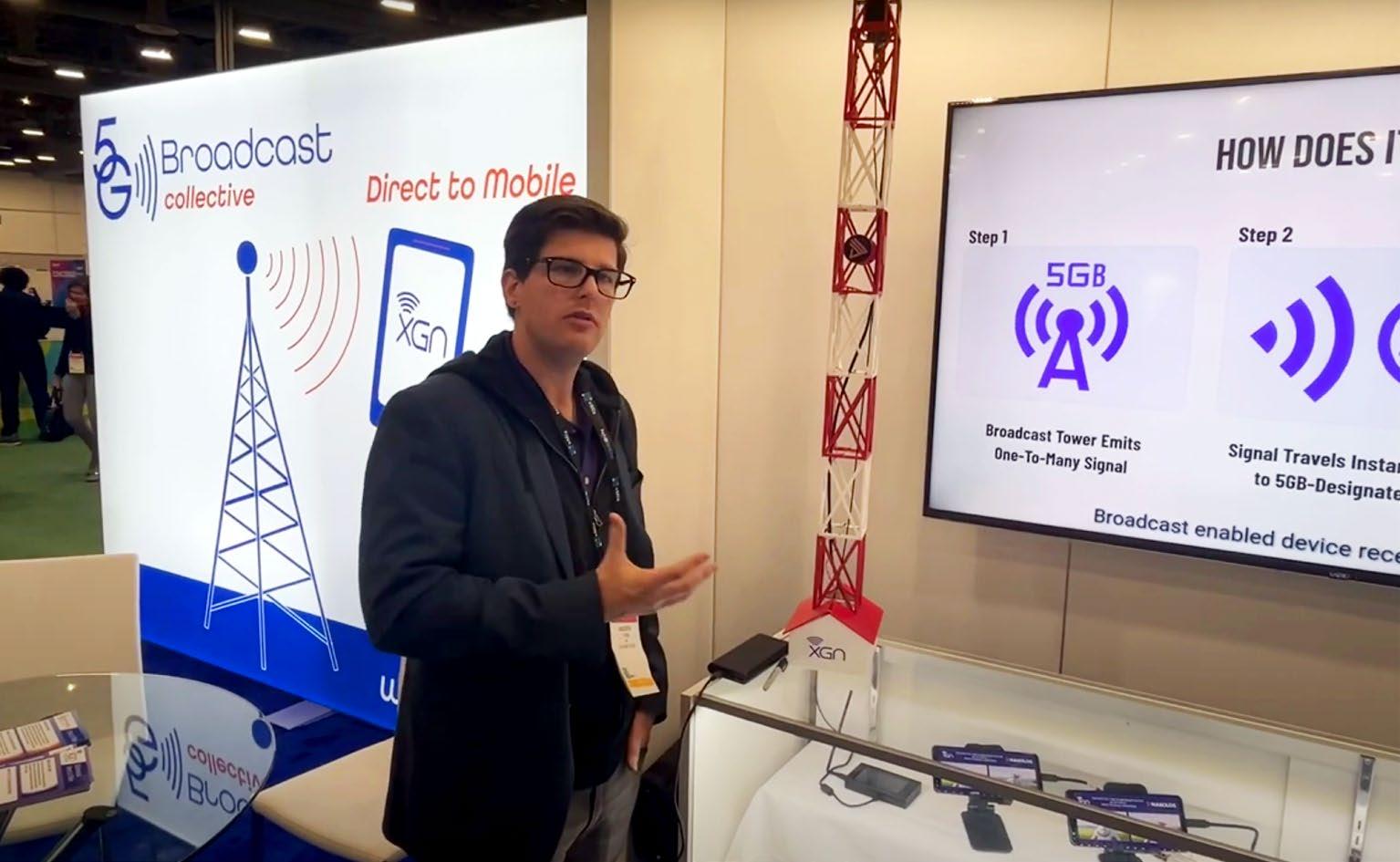
directional couplers to analyze reflections in the transmission line and antenna system. The paper shows how the distance to fault (or degradation) is calculated and some
examples of how it works, including detecting a problem inside a slot antenna.
The NAB BEIT proceedings are available for purchase ($100) and download at https://nabpilot.org/beitc-proceedings/ I made a presentation to the Public Media Venture TechConnect 24, held on Friday before the NAB BEIT. Billed as the “Master Class with Doug Lung: Analyzing TV Coverage – ATSC 1.0, ATSC 3.0 and 5G Broadcast,” I covered the different methods for calculating coverage, some of the software available for calculating coverage and how techniques used for calculating ATSC 1.0 coverage can be modified for calculating ATSC 3.0 and 5G Broadcast coverage.
The presentation showed how different propagation models and different transmission systems performed under different circumstances. It also includes an extensive reference section with links for further study. The presentation is available at https://www.transmitter.com/tc2024/ l
As always, your comments and questions are welcome. Email me at dlung@transmitter.com

By Sven Van Vlem Head of Technology News City at DPG Media
After 20-plus years at DPG Media, a leading player in the media and broadcast industry in Belgium, the Netherlands and Denmark, I currently serve as the head of technology for their news and sport operations in Belgium, where DPG Media owns numerous media brands like VTM (television) as well as radio stations (Qmusic, Joe), online services, magazines and a strong digital media presence with newspapers like HLN, AD and the Volkskrant.
News City where I work, is the headquarters in Antwerp for our news and sport departments and hosts our biggest news brands in Belgium, including VTM Nieuws, HLN and DeMorgen.
It’s an exciting time of growth for our company. A pivotal moment in this expansion was the recent move from our office in Vilvoorde to our new headquarters in Antwerp, marking a significant transformation in our operational setup. All equipment stayed in our datacenter in Vilvoorde whilst Antwerp became a full remote location.
In order to streamline these operations, reduce costs, and enhance overall efficiency, we are transitioning to an allIP infrastructure. We teamed up with our technical colleagues from RTL-TVI (a leading channel in French-speaking Belgium that is 50% owned by DPG), to identify a robust and proven IP routing solution that would support a decentralized workflow and meet our needs for flexibility and scalability.
Our implementation goals were clear: minimize development, limit risks, and ensure seamless integration. And with elections and major sporting events on the horizon, we needed a functional solution, not just a roadmap. After extensive research and evaluation, we chose EVS’ Strada routing
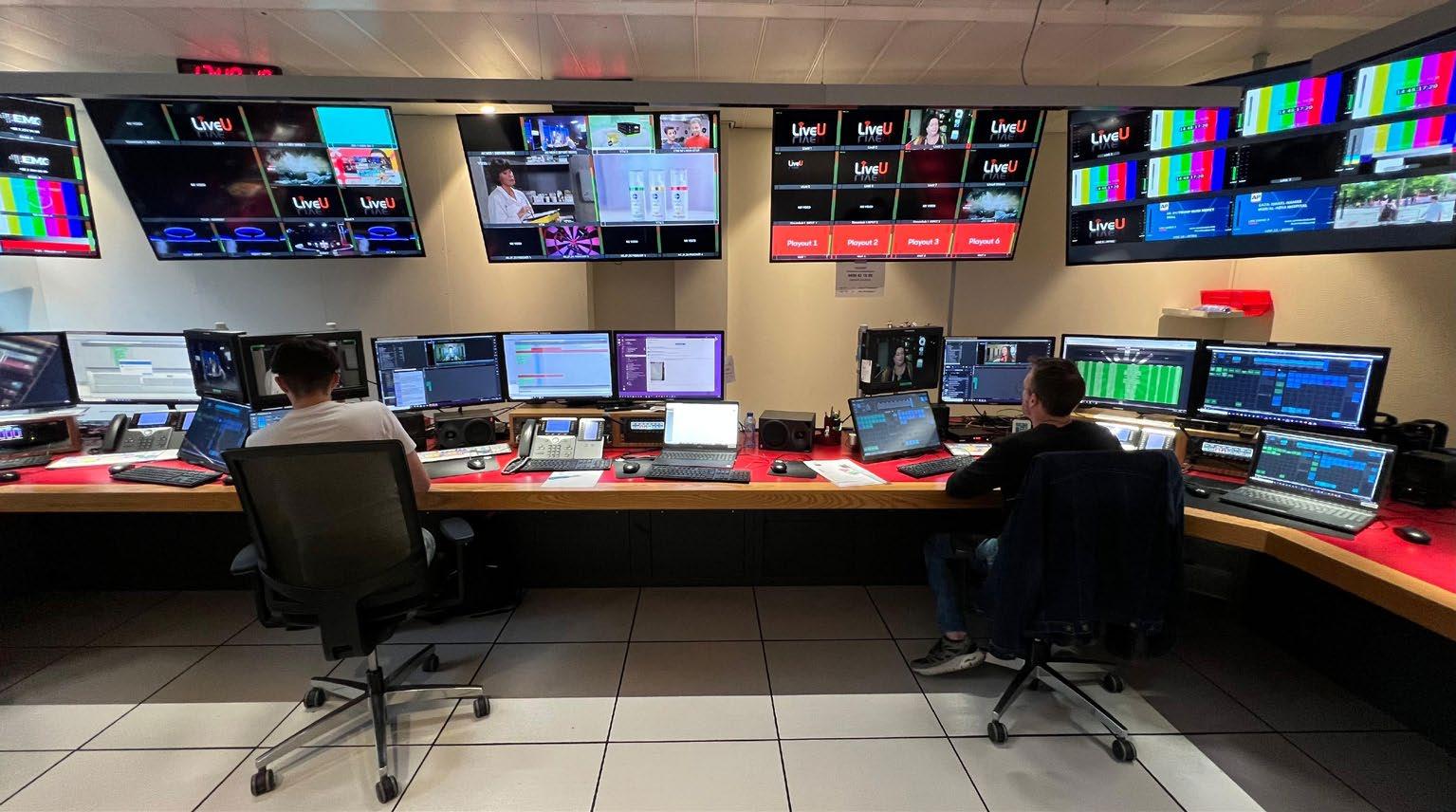
solution to replace our existing systems and SDI infrastructure.
Connecting our master control rooms the heart of our operations where all signals converge—the EVS Strada solution lets us work efficiently across various outputs and in conjunction with the galleries used for production. Built on the Neuron Network Attached Processor and Cerebrum broadcast control and monitoring system, it meets all the requirements for efficient and flexible broadcast operations: IP processing for audio and video, IP audio shuffling, JPEG-XS/ ST2110-22 compression, and HD/UHD up/ down/cross conversion. We’ve also added the new low-latency multiviewer, Neuron View, for monitoring multiple feeds in real-time using different layouts.
Thanks to Strada, our MCR team now has a single control platform to independently manage signals for news, entertainment, sports and digital channels across all locations. The solution integrates smoothly with our existing workflows, maintaining compatibility with our current SDI equipment while leveraging an IP backbone. This hybrid approach minimizes operational disruption and offers the benefits of modern IP technology, providing greater flexibility and scalability compared to traditional broadcast infrastructure.
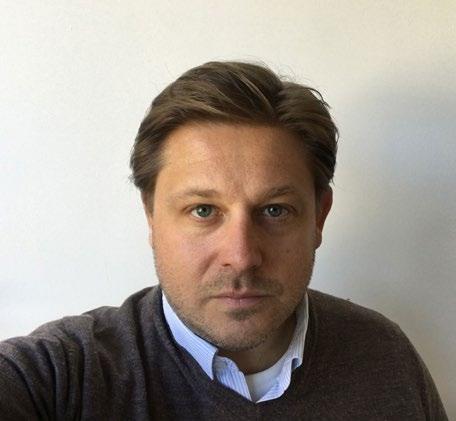
The new system has significantly boosted our functionality and efficiency, allowing us to create packages and organize sources logically, providing a better network overview and allowing us to save configurations for future use. This is a huge time-saver.
The customizable panels of Cerebrum are a major advantage, allowing our team to switch sources and manage signals independently, enhancing operational efficiency and user autonomy. Customization was a critical factor in our decision, and EVS was incredibly attentive to our needs. Together, we ensured the system was tailored to our workflows and UI requirements.
Although we are still in the early stages, the potential of this transformation is clear. We are fortunate to rely on such a professional team, guiding us through the biggest transformation our organization has undergone in the past 20 years. We eagerly anticipate the positive outcomes and continued growth that this new IP infrastructure will support. l
Sven Van Vlem is the head of technology for News City at DPG Media. He can be reached at info@dpgmedia.be.
For more information, visit https://evs.com
By Arsenije Alex Smiljanic CEO Broadcast Support GmbH
SCHAFFHAUSEN, Switzerland—Even after 15 years in the broadcast business as a broadcast engineer and master control operator, I still get a kick out of working for host broadcasters that cover top-tier events in Australia, New Zealand, the U.S., France, Germany and many other countries. Such events are increasingly occasions where the latest hardware and software technology is leveraged to tell even more captivating stories, using a growing number of tools and ever more cameras and audio feeds.
While server- or cloud-based, Lawo’s HOME Apps help reduce the host broadcaster’s footprint and be more agile. One of my most prestigious customers currently operates with two infrastructure kits to cope with rapid successions of top-tier events in different parts of the world and the number of video, audio and processing feeds keeps growing relentlessly. Operators at an IBC (international broadcast center) and elsewhere are expected to work lightningfast, without the slightest glitch that would be seen or heard by millions and upset event sponsors.
To keep things manageable, production teams of almost any size use a broadcast control system to boil down hundreds of individual actions and routing changes to a single press of a physical or on-screen button. Performing all these changes manually would take hours or even days.
Over the years, I have grown very fond of Lawo’s VSM broadcast control system, both for broadcast centers and OB trucks. VSM gives me total control over every piece of equipment and software that is involved in our storytelling: IP routers, video servers, audio mixers, multiviewers, gateways, and video processors. I like to control them all from a single GUI.
As far as the control layer and the graphic
user interface—which includes the way in which it is designed for the project—are concerned, I would not be able to operate the master control rooms I get to work in with the precision and speed required for the missioncritical tasks I need to perform without VSM. Those tasks include main signal routings, PCR assignments, scheduling automatic routing changes, even changeover strategies for disaster recovery.
VSM provides an intuitively customizable user interface to manage and control even the most complex broadcast setups. In addition, it offers the tools we need to monitor the health and status of IP routes, mission-critical gateways. When the stakes are high, the ability to identify and solve potential issues quickly is key. I like being able to create macros for complex operations to automate repetitive tasks and improve operational speed.
Redundancy (plan B scenarios) and reliability are equally important considerations. If a vision mixer stops working, for instance, VSM can provide a video switching panel that allows us to cut between sources directly from the matrix. The user experience may be slightly different, but VSM has already saved our lives in this respect.
Creating custom panels tailored to my specific workflows is almost as much fun as using them for the productions I design them for. Lawo’s VSM integrates with a wide range of third-party devices and systems, and its support for new protocols, APIs, etc., keeps growing. Another plus is VSM’s logging function, which monitors all aspects and lets us troubleshoot and analyze system and device performance in detail.
Throughout my career, I have obviously worked on projects where other control systems were used. From my experience, none of them comes even close to what VSM is able to provide. Basically, if you know what you want to achieve, VSM will be able to provide an elegant solution. l
Based in Switzerland, but active all over the world, Arsenije Alex Smiljanic has been a system broadcast engineer and master control operator for over 15 years. The CEO of Broadcast Support GmbH, he is on first call for entertainment shows, sports world cups, and studio operations. He can be contacted at alex@broadcastsupport.ch or via www.broadcastsupport.ch
More information is available at https://lawo.com
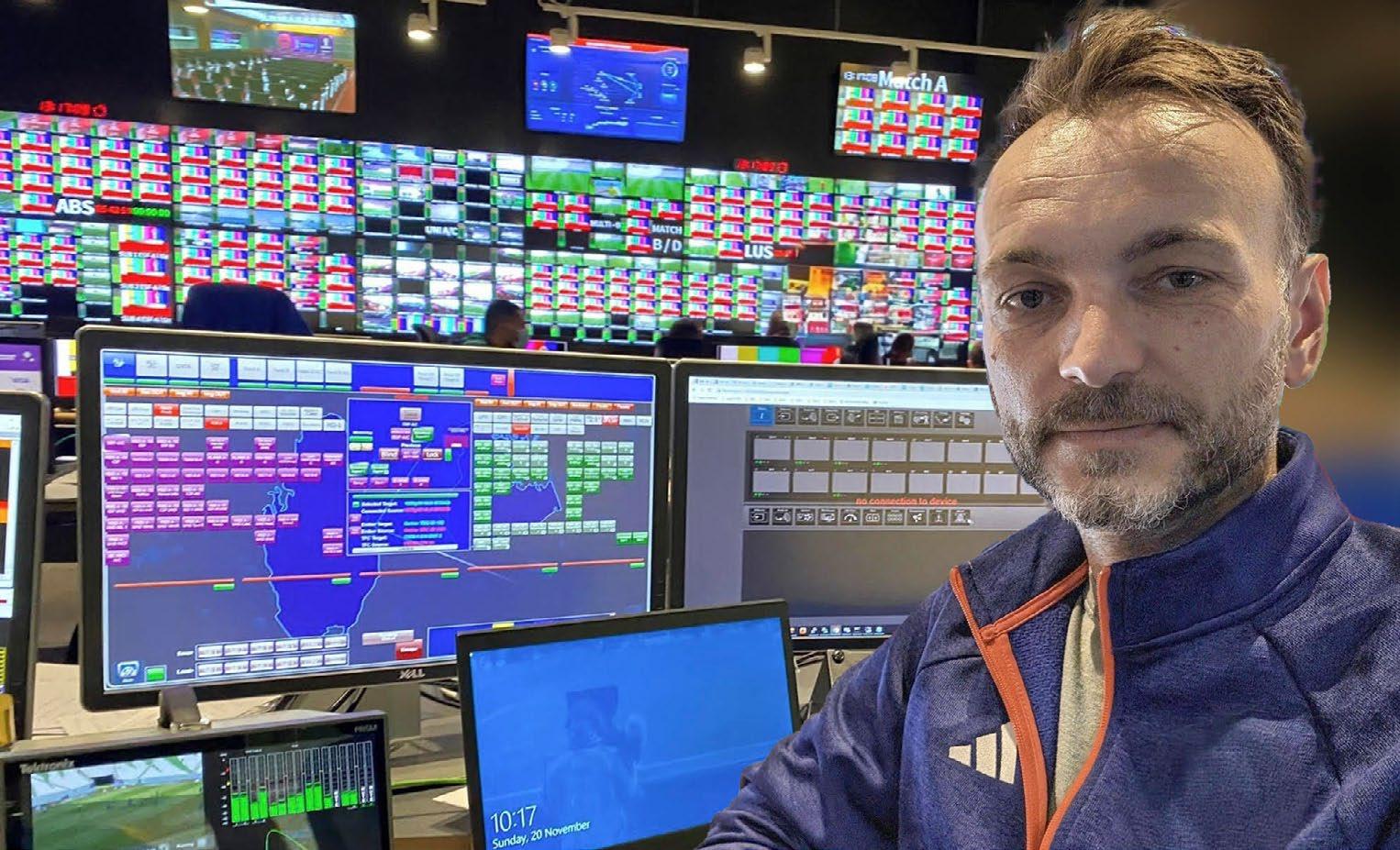
By Henry Crush IT Director WFMZ-TV
ALLENTOWN, Pa.—WFMZ-TV is a small independent TV station and yet we can boast running a lot of well-known, highend systems that are on the cutting edge of technology. The Black Box Emerald KVM systems we’ve deployed over the years are just one example.
In 2017 when we upgraded the WFMZ-TV studio, we installed Emerald KVM units to support our weather department. In addition to using Black Box copper-to-fiber converters to support signal transport over longer distances, we had already been using KVM technology to enable remote access to PCs and reduce clutter across our master control and news operations. We turned to the newer Black Box Emerald units to reduce bandwidth utilization and more effectively manage network resources.
With an incremental upgrade of our legacy KVM systems to Emerald units over subsequent years, we ultimately achieved a 90% reduction in network utilization, freeing up bandwidth for critical tasks such as internet connectivity and video editing. Because we consolidated PC and Black Box units onto the same switches, we kept infrastructure management straightforward while optimizing operational efficiency. By 2023, we had more or less standardized on the Emerald KVM units across our operations. During the NAB Show I visited the Black Box booth and saw a demo of the company’s new Emerald DESKVUE receiver, and I immediately thought of the many places we could use it. I was so excited about what DESKVUE could do within our master control department that I put in one of the first orders for the product after the show.
DESKVUE is a KVM-over-IP receiver that allows users to simultaneously monitor and interact with up to 16 systems, whether physical, virtual, or cloud-based. Working
closely with the Black Box team to navigate setup and configuration, we got DESKVUE up and running for monitoring in master control. Once again, I was impressed that the Black Box system maintained high video quality, even for monitoring multiple systems, while keeping bandwidth requirements low.
Once we figured out how best to utilize DESKVUE, we were able to seamlessly monitor four key systems across our main and disaster recovery site. We have configured the system with hotkeys assigned to different profiles so that each operator has instant access to the right systems for their job. By giving our operators the ability to view multiple systems at a glance, DESKVUE has proved to be a powerful tool for quickly fixing on-air problems; it’s easier to spot any issues faster because different rundown playlist computers are right there, front and center.
WFMZ-TV operates 11 channels, including a primary channel with 9.5 hours of news coverage per day, a 24-hour automated weather channel, and several subchannels. Black Box systems support both daily operations and special events.
For instance, we rely on the company’s
fiber extenders for signal extension during our broadcast of the local FREDDY Awards for musical theater in area high schools, as well as our annual coverage of the Philadelphia Mummers Parade — a folk parade held every year since 1901 — for MeTV2 on our sister station, WDPN-TV. We now also count on DESKVUE to help minimize recovery time in the event of any issues, in turn reducing any negative impact.
Being one of the very first DESKVUE users, we have appreciated the proactive support from Black Box. For a smaller station like ours, it makes a difference to receive individualized support along with the sale. Overall, this approach has allowed us to leverage the latest in KVM technology, and to manage our existing technical and human resources more effectively to serve our viewers. l
Henry Crush has been IT director since 2022 and has been with WFMZ since 2005. He is responsible for installation and maintenance of new and existing IT/IS hardware and software. He can be reached at HenryC@wfmz.com
More information is available at www. blackbox.com
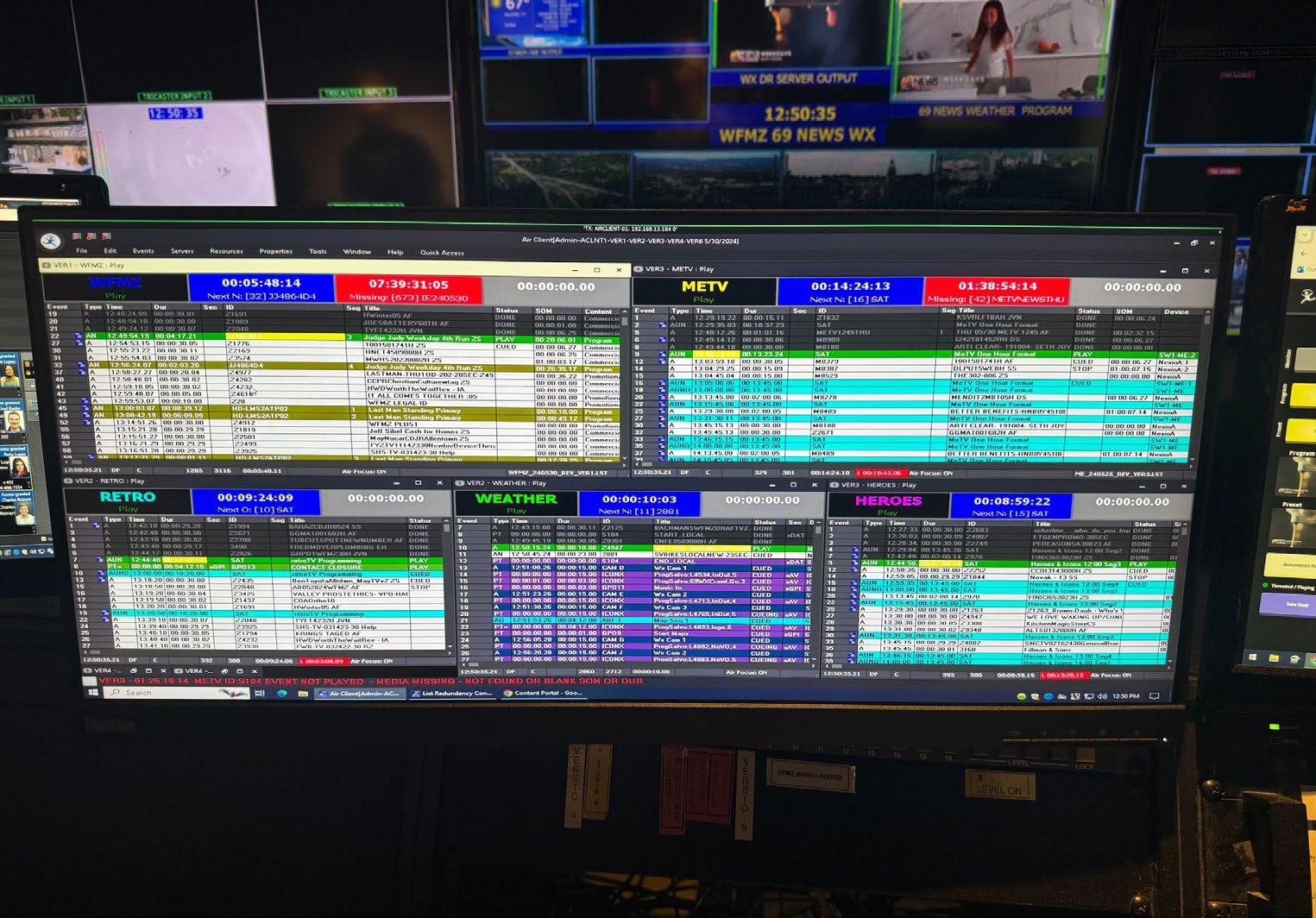
One of the country’s largest high school broadcasting platforms uses Blackmagic Videohub Router at the center of its
By Josh Hinkle Technical Lead, Creative Jackson Academy’s Raider Network
JACKSON, Miss.—With a legacy of excellence and innovation, Jackson Academy’s Raider Network has become one of the largest and most influential high school broadcasting platforms in the nation.
We use a 35-foot production truck for broadcasting sporting events as well as band performances, school plays, choir competitions, and various other on- and offcampus events. Equipped with more than 15 cameras, 12 channels of instant replay, 48 channels of high-quality digital audio, and three channels of professional-level graphics, the truck ensures that every moment, every play, and every cheer is captured with precision, delivering an unforgettable experience for both the live audience and viewers at home.
The backbone of our workflow includes a host of Blackmagic Design products, which have been instrumental in elevating the quality and capabilities of our broadcasts. The Blackmagic Videohub router—a pivotal component that simplifies our video stream management—is at the heart of our operations. This robust router handles video streams of all frame rates and sizes, seamlessly routing them to nearly every piece of equipment in our state-of-the-art broadcast truck. With 25 outputs connected to our ATEM Constellation 8K live production switcher, we enjoy unparalleled flexibility, enabling us to produce a wide range of content.
The router’s built-in fiber cards are a game-changer, allowing us to transmit video signals over miles via single-mode fiber optic cable. This ensures we can cover events regardless of location on campus. Our custom-made breakout boxes simplify signal flow management, making it incredibly easy to route video signals anywhere we need with just a click.
Integration with third-party software
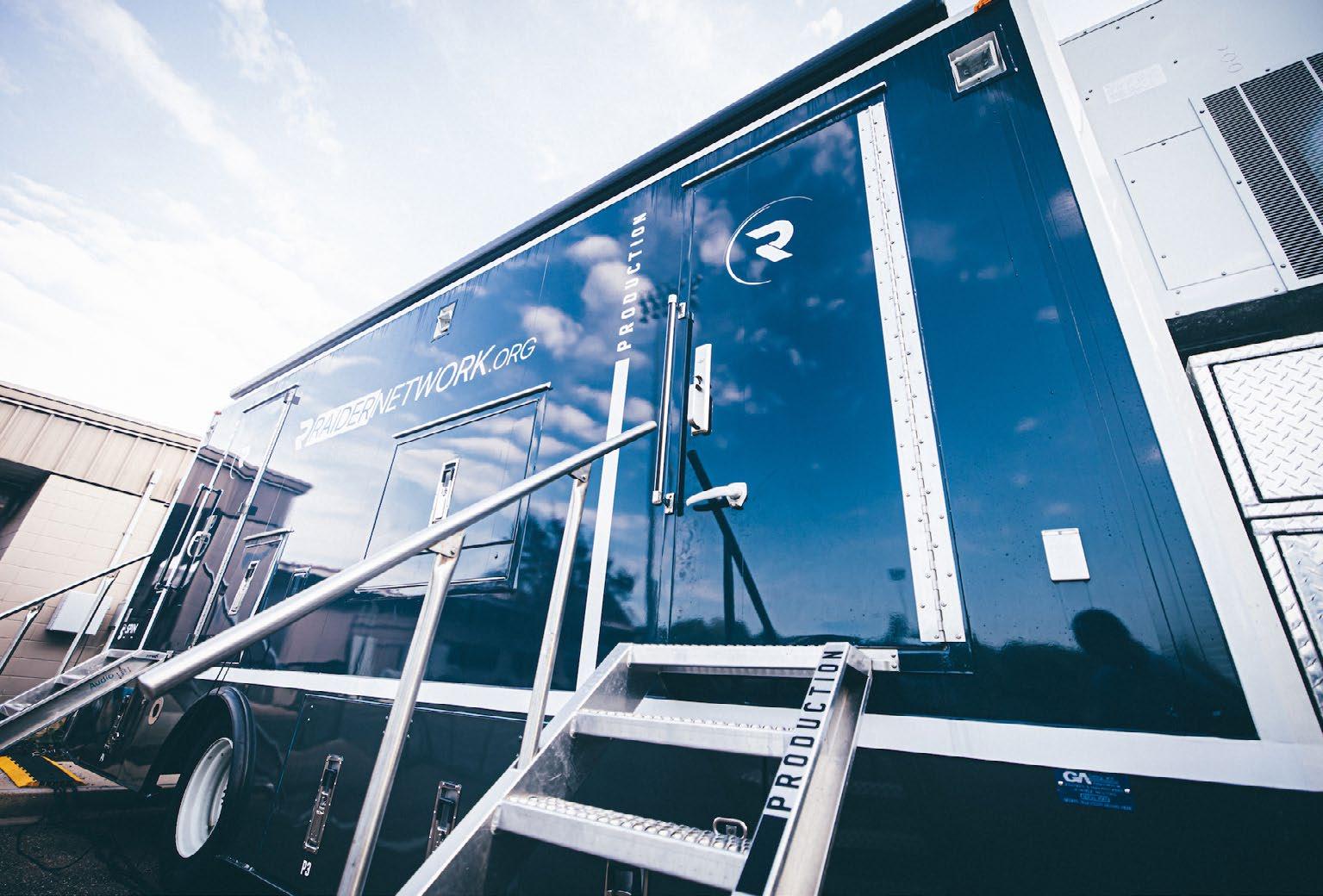
elevates our control over the Videohub, enabling us to manage routing both on site and remotely. This feature is particularly beneficial for offsite productions, ensuring we maintain seamless operations regardless of our physical location. Nearly all video signals pass through the router, which efficiently handles both video and audio, directing them precisely where needed and providing our production team with exceptional flexibility.
The Videohub also connects to three frame syncs, our Blackmagic Mini Converter SDI Distribution, the truck’s exterior patch panel, Blackmagic HyperDeck and HyperDeck Mini broadcast recorders, streaming computers, and more. This extensive connectivity allows us to maintain a versatile and adaptable production environment, ensuring that all our broadcasting needs are met efficiently.
With the Blackmagic Videohub router at the core of our setup, we are equipped to deliver high-quality, professional broadcasts that showcase the diverse talents and events at our school.
Jackson Academy’s Raider Network doesn’t just pursue broadcasting excellence but is also committed to nurturing the talents of the
next generation, allowing broadcast students to run cameras, conduct replays, operate the scoreboard, serve as parabolic mic operators, and more.
It’s a journey that extends far beyond the realm of high school, equipping students with essential life skills and giving them a glimpse into the world of high-stress, live broadcasting. The Videohub, and all other Blackmagic Design gear, not only provides us with unparalleled quality and flexibility for our broadcasts but is easy to use and fast to learn, so even our students can use it.
Our awe-inspiring setup wouldn’t be possible without the cutting-edge technology that underpins the Raider Network’s operations. Blackmagic Design’s products ensure that Raider Network offers an immersive experience for its audiences like no other. l
Josh Hinkle is a graduate of the Jackson Academy Class of 2015 and Ole Miss (2019) and served on the Ole Miss production crew in conjunction with the SEC Network. He can be reached at joshhinkle4@gmail.com.
For additional information, contact Blackmagic Design at 408-954-0500 or visit www.blackmagicdesign.com

OG-KVM-IP-Tx-UHD is a 4K@60 KVM over IP solution designed for the openGear frame, bringing broadcast industry reliability into KVM technology. The OG-KVM-IPTx-UHD is hot-swappable, with up to 10 cards installable in a 2 RU openGear frame, featuring dashboard control, network monitoring, and redundant power supplies. This solution operates on a distributed architecture, eliminating the need for a central KVM server. Apantac KVM management software can run on any PC within the IP network and ensures system operation without requiring the software to be actively running.
When paired with Apantac 4K@60 KVM receivers, operators can extend or switch HDMI video streams with visually lossless quality and ultra-low latency of 2 milliseconds. It includes transparent USB 2.0 ports for keyboards, mice, control panels, touchscreens, webcams, and more, as well as RS232, GPIO, and Infrared control over IP.
www.apantac.com

Ultrix is designed to be more than a traditional routing platform by offering users “infrastructure in a box.” Ranging in sizes from 16x16 to 288x288 in a single chassis, to significantly larger in distributed architectures, the compact design of Ultrix provides big performance in little space, making it a natural fit for space conscious applications like mobile production. Its integrated Ultricore control system provides users a great way to configure, monitor, and control Ultrix via both software and hardware panels that scale based on budget and size.
Being software-defined means users can enable the functionality they need–multiviewer, framesyncs, clean/quiet switches, etc.—when they need it without losing critical time occupying scarce I/O slots. In addition, the revolutionary SDPE board allows users to add either Acuity or Carbonite switchers directly inside the frame.
www.rossvideo.com
ASTRA Media Factory is designed to be one platform with three dimensions. The first dimension is services covering the asset lifecycle, automating studio production, media management, playout, and distribution, allowing users to create, manage and deliver. The second dimension is environment: ASTRA Media Factory operates in any combination of on-prem, remote, multicloud.

The third dimension is integration: Aveco’s comprehensive library of integrated third party products allows the best selection of products, now and in the future.
The flexibility of these three dimensions together with unified workflows and a unified user experience spanning environmental boundaries, delivers solutions precisely crafted to media company needs, while minimizing retraining as systems expand locally, remotely, cloud and in hybrid.
www.aveco.com/en

By James Crawford Director of Engineering News-Press & Gazette Co. (NPG)
ST. JOSEPH, Mo. We’re a medium-sized broadcast group with multiple network affiliates across 10 markets, but we face the same challenges as other industry organizations, large or small.
If we want people to see us, then we need to be on every media platform. We couldn’t provide diverse programming and services on our increasing number of channels and stations without reliable and efficient master control, program automation and distribution.
We found the right platform for our needs with the Crispin Corporation, a Sony Group Company. The Crispin solution provides a browser-based playlist tool, webRPX, allowing for reliable and flexible control. Plus, Crispin’s CORE and its full suite of applications, is built to support a hybrid approach of on-prem, VM, and multisite.
We pride ourselves on local news coverage and in many of our markets we are the news leader. When viewers tune into live programming, everything must be dialed in perfectly—fractions of seconds can be the difference between ruining or enhancing the viewing experience.
In the fall of 2023, we deployed the Crispin software suite at our broadcast operations center (BOC) in Colorado Springs, Colo., and we are aggressively rolling it out to the remainder of our markets. We quickly began seeing the benefits—dependability and less time spent troubleshooting on-air issues, resulting in a better working environment and improved programming for our viewers. I can best describe our search for a viable master control and automation platform as preparing for the future by going “back to basics.” Our industry used to be focused almost exclusively on hardware; now that’s become largely a commodity with so many software options on the market.
However there are still legacy workflows that aren’t going anywhere anytime soon. SDI is still a part of our plans. The resources simply aren’t there to redo each station and become a full IP house. IP will take the place of baseband, but the on-ramp to get there is still pretty long.
Crispin offered an ideal softwarebased platform that fits how we work today, allowing us to manage our existing baseband infrastructure and on-premise workflows. It also gives us the flexibility to leverage cloud and IP for future growth. It’s the best of both worlds.
Our BOC and market stations operate on a hub-and-spoke model. A few years ago, we were deciding between centralizing at the hub and transporting programming to the spokes or keeping the heavy lifting on-premise at the spokes with remote control managed from the hub. We chose the latter option.
Also, since we don’t have the resources for dedicated fiber or satellite uplink between all our facilities we rely heavily on public internet. The system we chose had to be resilient and able to run 24/7 without much maintenance required, which was especially
important since we have added channels and services but not the staff.
With Crispin, we have granular system-wide control over a reliable remote IP connection and the assurance that all programming and ad content is being delivered and inserted properly with no downtime.
At one of our stations in the Crispin roll-out phase, our legacy automation system failed, and we were facing the prospect of dead air. But the Crispin system was running and even though it wasn’t fully commissioned, we flipped over to it to provide an hour of programming we otherwise wouldn’t have had.
That invaluable peace of mind is worth any time or costs involved with new technology, and we’re confident that as our needs change, the Crispin suite will grow and adapt with us. l
James Crawford is director of engineering for St. Joseph, Missouri based News, Press & Gazette Broadcasting. He is based out of Idaho Falls, Idaho. He can be reached at james.crawford@npgco.com.
Additional information is available at www.crispincorp.com
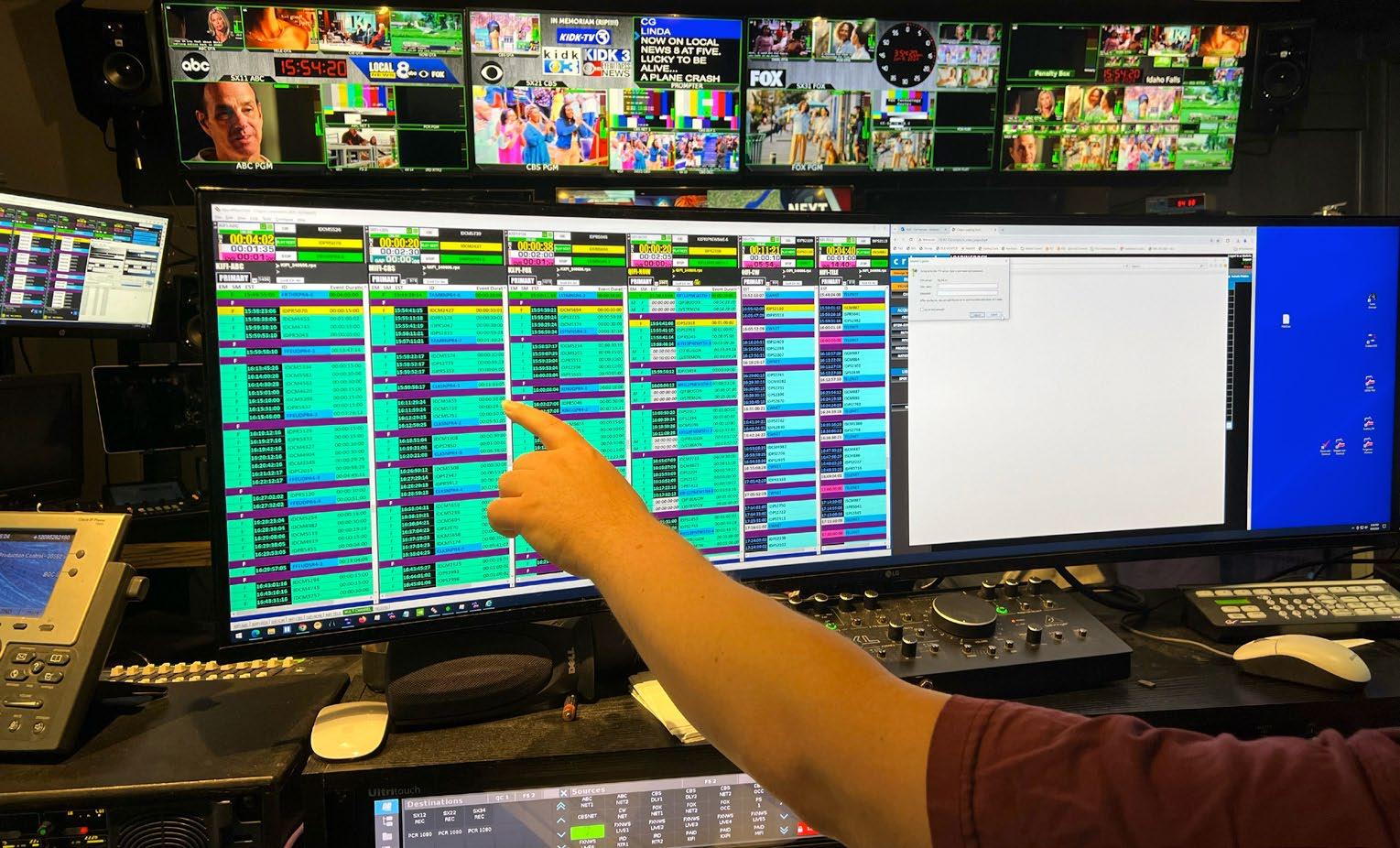

Viz Connect Tetra is an ultra-compact live production workstation that enables multichannel 4K video and audio connectivity with a simple internet or network connection, anywhere in the world. It is designed to meet the ever-changing demands of multicamera, on-location, live productions with four flexible channels supporting up to 4K. Viz Connect Tetra’s I/O channels can be used as up to 12G NDI to SDI, 12G SDI to NDI or even NDI to NDI; it is at home in a server room rack as it is on a desk, on location, wherever connection is needed.
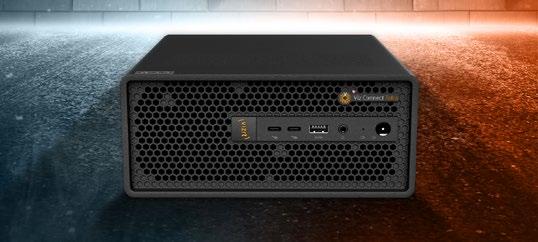
The new DynamicWorkplace-CON enables seamless integration with a G&D KVM matrix system for consolidating CON modules and monitors. This integration creates an efficient working environment and reduces physical strain on users. The multiviewing function allows the control of up to eight sources on four monitors simultaneously.
Its compact footprint with 12G 4K UHD output, and the inherent secure encryption workflow provided by NDI Bridge, with the data center host in control of connections, makes it the perfect desktop companion for postproduction professionals to land their program output to broadcast grade displays, wherever they are.
https://www.vizrt.com
The MediorNet FusioN compact edge devices for I/O and processing, include the FusioN 3, FusioN 3 Fanless, and FusioN 6. They feature versatile configurations, serving as encoders, decoders, and video splitters. With minimal power consumption and a small form factor, they optimize production efficiency by being placed near signal sources or destinations.
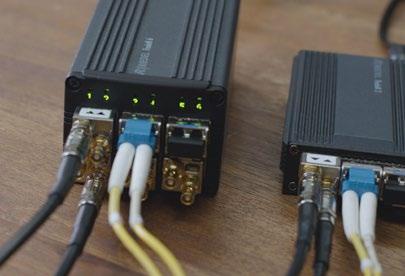
FusioN edge devices act as compact gateways, linking SDI/HDMI and fiber to IP ST2110 formats, supporting JPEG-XS. Their small size allows discreet placement behind monitors or near cameras, instantly upgrading HDMI monitors or SDI cameras to ST 2110. FusioN frames include dual fiber transceivers for ST2022-7 hitless redundancy. The FusioN 6B model adds a 1GE Ethernet control interface for seamless control data exchange and offers PTP to black burst for on-site camera genlock provision. www.riedel.net
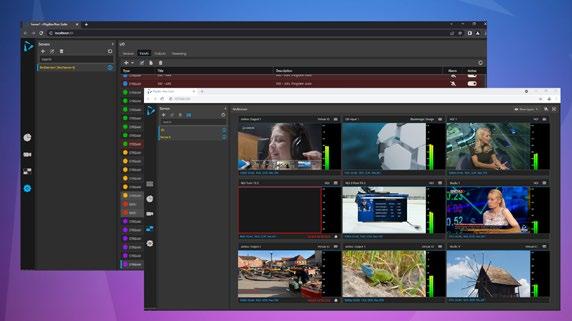
Media Gateway is a live media delivery and distribution solution based on the PlayBox Neo Suite platform that can be installed on-prem or in the cloud. Media Gateway allows the reception, transmission and conversion of a wide range of broadcast signals to simplify the everyday tasks of content delivery and distribution. Signals can be sourced from and converted to SDI, NDI, SRT, UDP or RTP. Media Gateway also has a Screen input which allows video and audio content to be grabbed from a desktop and delivered as live feed.
All uncompressed outputs and the encoder allow frame-rate, up/down and cross conversion as well as aspect ratio conversion plus generation of black, bars and freeze on the output when there is no signal. Every input can be delivered to one or many outputs in the same domain. The IP decoder supports both Multiple and Single Program Transport Streams. https://playboxneo.com
The design is optimized for integration with G&D matrix systems. Users can adjust the arrangement of individual computer signals in real time, providing unparalleled flexibility and control. The window manager of the workplace module enables free window positioning and flexible monitor arrangements. Audio signals, serial signals, and USB devices can be individually utilized, while an ergonomic display of critical data enhances efficiency and safety in control rooms.
www.gdsys.com/en-us


Central Control is for operators who require greater flexibility to execute all the processes that converge into playout. A fully integrated master control solution and automated toolset, Central Control enables operators to enjoy maximized efficiency through capabilities that deliver full linear channels. .
Central Control can manage many channels through its multichannel Control Panel, which can be utilized remotely or from a central operations center, giving them greater control in today’s expandable environment. Multichannel operation and large-scale ingest of content is easy, particularly from third parties. Key benefits include: content validation and asset matching make broadcast playout nearly bulletproof; optimized workflows with flexible tools for master control operations; and users can manage, schedule, and go to air easily and efficiently.
https://bitcentral.com
Utah Scientific’s new 400 Series platform is the perfect choice for high-density SDI coupled with the ability to create high-density IP signals from the same central frame. Backed by the company’s renowned support and reliability, the 400 Series can handle any number of IP and SDI professional video signal formats along with a number of audio and data formats.
The Utah Scientific 400 Series is designed as a purpose-built hybrid router that includes not only SDI but IP signals. From standard-definition and analog signals all the way up to 3G and HD resolutions, the Utah Scientific 400 Series can handle both SMPTE ST2022 as well as the new SMPTE ST-2110. For audio, the 400 Series supports analog, digital AES3, MADI, TDM, and the new AES67 formats.
https://utahscientific.com
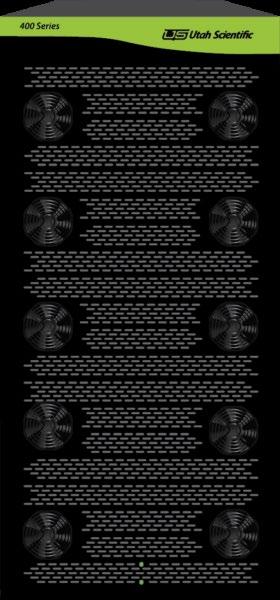
By David Dowling COO
by Block Solutions
LOS ANGELES—Block by Block Solutions specializes in audiovisual solutions for unique postproduction environments. We offer turnkey services, from architectural drawings and consultations to installation, programming, and servicing, ensuring that every project meets our high standards.
Excellence isn’t just a platitude; it’s necessary in the high-stakes world of Hollywood production where millions of dollars are on the line and things move fast. The solutions we spec and install must be of the highest caliber, so we’re constantly on the lookout and evolving to ensure our clients’ systems are outfitted with the very best. In 2019, during an installation project for Blumhouse Productions, we decided to start using IHSE as a product standard for clients of Block by Block Solutions.
Blumhouse Productions is renowned for its prolific output in the horror and thriller genres and in recent years the company has been expanding its footprint to support that growth. They gutted former office space to add about 20 additional edit bays as well as upgrade their screening room, which serves as a multipurpose space for color correction and audio mixing.
This project presented some unique challenges, particularly the need to integrate new systems with the existing infrastructure. The main requirement was to create a seamless integration where new and old edit bays could be controlled locally and remotely, with full KVM functionality extending to their screening room.
The studio had an IHSE system that was installed about 10 years ago, running DaVinci Resolve for color correction and Avid Pro Tools for audio mixing. We realized these solutions were a testament of longevity and reliability, and IHSE is a great partner for building out solutions for our client’s unique demands.
IHSE stood out in two ways: Its support for legacy products and their direct connection with Pro Tools. IHSE enabled us to integrate the new and old systems, providing a seamless user experience. All it took was a firmware update on the old IHSE equipment to ensure compatibility and performance. With a direct connection with Pro Tools, we were able to streamline operations significantly. This meant that Blumhouse could maintain their existing workflows without sacrificing any functionality—a crucial aspect for their operations.
IHSE has a reputation for engineering robust and reliable KVM solutions. In fact, the IHSE name is well-known in missioncritical applications such as air traffic control. While post-production isn’t life-critical, it does demand uninterrupted and flawless operation due to the significant costs and tight schedules.
In practical terms, the IHSE KVM system allowed for instantaneous switching between different edit bays and the screening room. This capability is essential in a fast-paced production environment where every second counts.
The IHSE system’s ability to handle multiple resolutions was another advantage. We had to accommodate both 1080p video signals and higher resolutions for different tasks within the same environment. Security was also a top priority as film piracy continues to escalate. IHSE KVM switches meet TPN (Trusted Partner Network) requirements, ensuring that all data and operations remain secure, which is vital for a studio handling high-value content.
IHSE’s support team was instrumental in helping us deploy, program, and troubleshoot
the systems. The ease of integrating new technologies with a decade-old system was impressive and highlighted IHSE’s commitment to backward compatibility and long-term support. This not only saved Blumhouse money but also ensured continuity and reliability in their operations.
A few years into using the system, Blumhouse continues to benefit from the robust, flexible, and reliable IHSE solutions. They’re an indispensable part of their upgraded facilities and our ongoing service contract with them. The seamless integration and operational efficiency have significantly enhanced their production capabilities, allowing them to focus on what they do best—creating compelling content. What’s more, IHSE’s reliability, flexibility, and outstanding support have set a new standard for us. l
David Dowling is the COO of Block by Block Solutions in Los Angeles. His background includes more than a decade of studio integration expertise. He can be reached at david@blockbyblocksolutions.com.
For more information, visit www.ihse.com
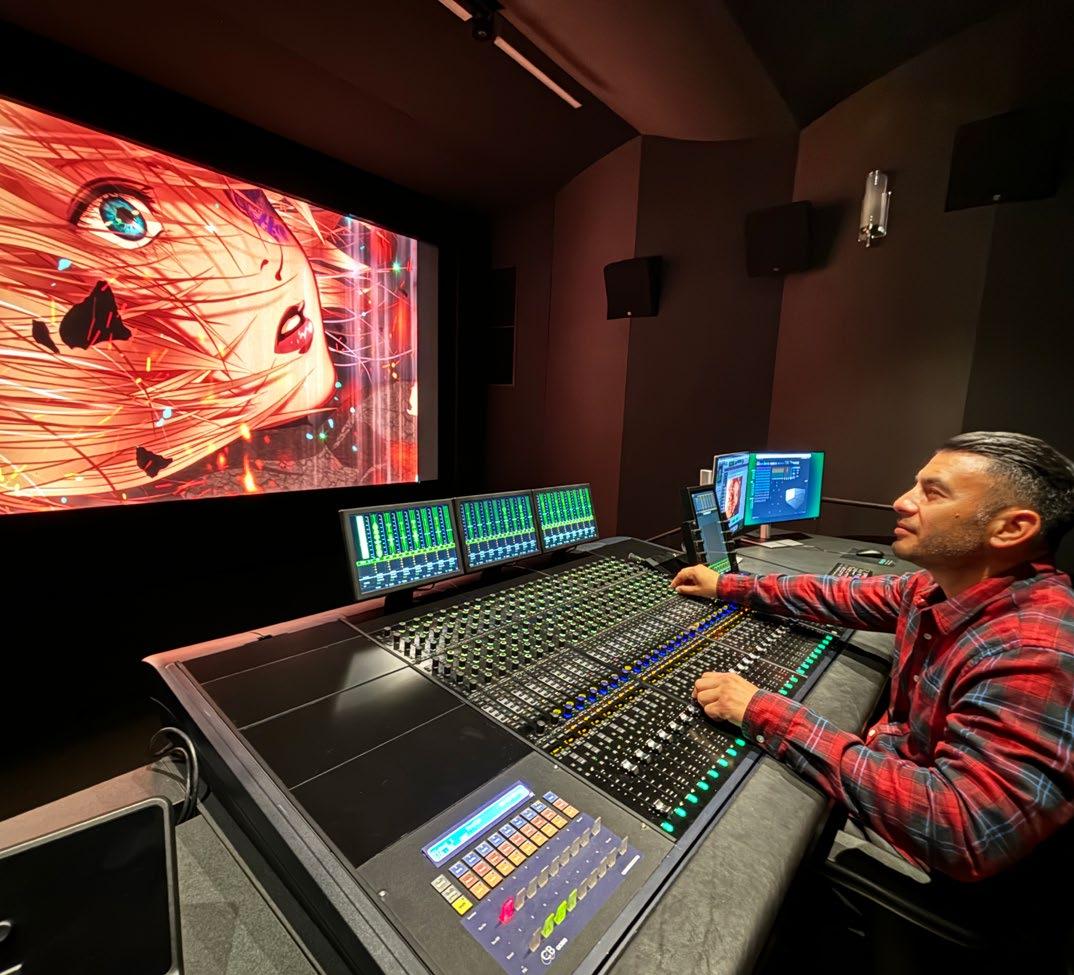
By Al Krause Network Operations Manager Nebraska Public Media
LINCOLN, Neb.—Starting out with a single over-the-air channel in 1954, Nebraska Public Media has been providing news, education, entertainment and sports programming for the last 70 years.
We now support five live-to-air TV channels, two radio channels and online resources. In addition to producing live community and news programs, we broadcast programming from PBS and NPR on TV, radio, online, social media and mobile apps. We transitioned into streaming when we began broadcasting live gavel-to-gavel coverage of the Nebraska Legislature.
The Emergency Alert System is also a huge portion of what we do, and as the State Emergency Communications Committee Chair for Nebraska, I help with a lot of EAS activities. In addition, we serve as the backup for the PBS Diverse Disaster Maintenance System, which means we cover the entire country with PBS signals when serious weather hits the East Coast.
It’s a lot to manage, and I have spent the last 29 years helping the station connect its local communities to the world and each other.
As network operations manager, it’s my job to keep everything on air, and I’ve been working with Imagine Communications products since 2000 to ensure our master control infrastructure meets our changing needs.
We use Imagine’s Versio integrated playout engines for channel origination, four Nexio+ AMP servers for record and quality control, Nexio Motion for media asset management, and ADC automation for content control and delivery. The Versio offline Creation Station enables us to quickly create a snipe or a crawl for sports or for EAS alerts. In addition, we use Selenio encoders for transcoding, which enables us to operate 12 live streaming channels and create VOD files for PBS
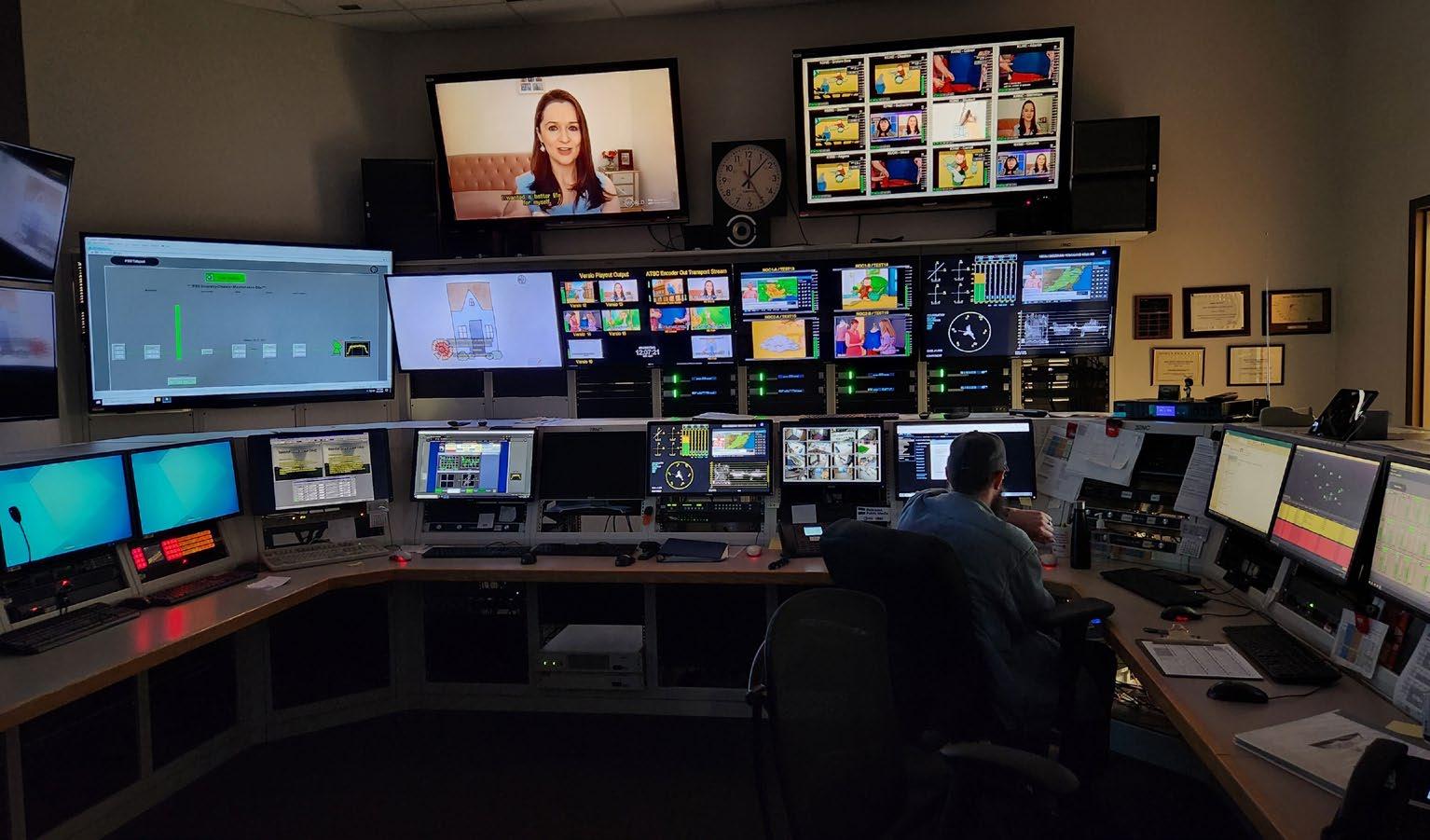

Passport delivery.
Imagine ties everything together, and everything is interoperable. The Nexio Motion software moves files around our facility, including to Avid editing stations and to the web, making our file-based workflow perform efficiently. In total, we have 91 workflows built in the Motion system to shuffle files around in our facility.
All of our signals go to air through the Versio platform, with each of our five channels split between two ADC Air Clients, which let us monitor and control multiple playout and ingest channels from a single UI. Our operators are very comfortable with this setup, as we have been using ADC for years, and the Versio is mostly hands off.
Automating our workflow helps simplify all our on-air operations, and the fact that our operators don’t have to touch it illustrates the reliability of the Air Client and how well
it works. The playlist is everything, and the Versio platforms just run and run.
As time goes on, our services keep developing, and Imagine products enable us to grow alongside them.For example, our tie-in with the Nebraska Legislature requires a big commitment to record facilities, and we recently upgraded our Nexio servers to provide the capacity for 16 HD record channels. Next year we’ll add English and Spanish captioning to the Legislature—for each floor debate as well as all its hearing rooms—which we are obliged to copy for the public archives.
Finally, like most of our broadcast peers, we are starting to plan for the inevitable transition to IP, and we know that Imagine gateway products enable a hybrid environment and gradual migration to ST 2110. l
Al Krause is network operations manager at Nebraska Public Media. He can be reached at akrause@nebraskapublicmedia.org.
More information is available at https://imaginecommunications.com

KUMO 3232-12G offers increased capacity for medium sized configurations while maintaining a compact 2RU profile with support for 12G-SDI/6G-SDI/3G-SDI/1.5GSDI from 32x 12G-SDI inputs and 32x 12G-SDI outputs. It supports ganged dual and quad port routing control, allowing users to group together multiple inputs and outputs for Dual Link, Quad Link 4K/ UltraHD, and 8K/UltraHD2 workflows.
KUMO 12G-SDI routers support large format resolutions, high-frame rate and deep color formats, while reducing cable counts when transporting 4K/UltraHD over SDI. The routers offer network-based and/or physical control using KUMO CP and CP2, and mirror the physical form of AJA’s productionproven KUMO 3232 and KUMO 1616 routers, with a USB port for configuring IP addresses via AJA’s eMini-Setup software. https://www.aja.com

The Matrox Video Extio 3 Series are secure, high-performance IP KVM extenders that support 4Kp60 or quad 1080p60 video, keyboard, mouse, USB 2.0 and audio at low bitrates over 1 GbE networks. The Matrox Extio N3408 quadmonitor IP KVM extenders support one 4Kp60 4:4:4, two 4Kp30, or up to four 1080p60 video streams over IP, or can be configured as a direct point-to-point KVM over CATx or fiber optic cable. TAA compliant SKU available.
Matrox Video Extio N3208 dual-monitor IP KVM extenders supports dual displays (2x 1920x1200 @60Hz) or a single high-resolution display (2560x1600 @60Hz) over IP or can be configured as a direct point-to-point KVM over CATx or fiber optic cable. TAA compliant SKU available. https://video.matrox.com
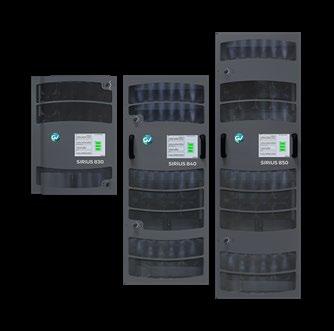
The enterpriselevel Sirius 800 series of routers offer multiformat, expandable routers with exceptional performance, flexibility and reliability, with a range of frame options from 288x288 to 1152x1152 and beyond with I/O options including SDI, AES, MADI and 12G-SDI. Sirius 800 benefits from advanced hybrid processing (AHP) integrating functionality that would otherwise require extensive external modular infrastructure, including audio processing, frame synchronization, clean and quiet switching, video and audio delay and audio sample rate conversion. AHP includes input embedding with no external loopbacks; a unique, innovative technology from Grass Valley.
Other key features include: embedded, MADI, AES3; ability to take audio from any input type from AES3 to 12G; the ability to replace any or all output cards with MV-841 or MV-851 multiviewer cards; four internal timing planes; fully asynchronous audio; auto detection of the input format will deembed from any format automatically, etc. www.grassvalley.com


For possible inclusion, send information to tvtech@futurenet.com with People News in the subject line.

Tegna has hired Michael Steib as its new president, CEO and a director, succeeding David Lougee as of August 12, 2024. Steib is currently CEO of Artsy, a large online platform for discovering and collecting art, after serving as president and CEO of XO Group, parent company of The Knot. Previously, he spent 10 years in executive positions at NBCUniversal and Google launching, scaling and acquiring advertising-supported businesses.

E.W. Scripps Co.
E.W. Scripps Co. has named Robin Davis SVP, chief distribution officer. She will oversee the team responsible for managing distribution across cable, satellite and virtual carriers as well as multicast spectrum. Davis has been serving as the interim head of distribution since February. Davis joined Scripps in 2005, holding a variety of strategy and finance leadership positions. Her most recent role was senior vice president for strategy, planning and development.
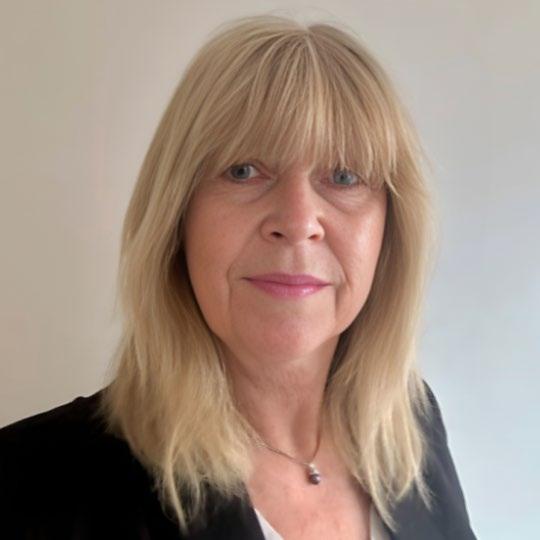
Pebble
Sally Wallington has joined Pebble as SVP of sales, with responsibility for the company’s worldwide sales efforts. Previously she was sales director at VSI. She also held director-level appointments with other media technology companies, including Grass Valley and Imagine Communications. Wallington will collaborate with teams worldwide to accelerate the company’s market share growth and align sales strategies with core principles of innovation and customer satisfaction.

Ateliere Creative Technologies
Ateliere Creative Technologies has hired Eugene Sarmiento as its vice president of sales and business development for Europe, the Middle East and Africa (EMEA). The company said he offers an entrepreneurial management style that balances business acumen and technology knowledge gained from past roles that have included leadership positions at Operative, Salesforce and Ericsson. Sarmiento will help drive growth for Ateliere’s cloud-native media solutions.

EditShare has hired Grant Carroll as its new senior vice president for sales for the Americas. He was with EditShare for nearly 20 years as former director of workflow design and director of sales before taking a career break in 2022. After working for Alteon.io, Cinedeck and OpenDrives over the past year, Carroll has returned to EditShare with responsibility for all sales from Alaska to Tierra del Fuego. He reports to Tara Montford, co-founder and EVP of sales.

Nexstar Media Group has appointed Lisa Taylor SVP of digital advertising sales, where she will be responsible for accelerating digital revenue growth across the company’s broadcast group. During a 20+ year career in advertising sales and marketing, she joins Nexstar from Amazon, where she served as senior business development manager for the company’s worldwide emerging business, Amazon Ads. Prior to Amazon, Taylor held sales and marketing leadership positions with Meredith Corp.

E.W. Scripps Co.
E.W. Scripps Co. has hired Charlie Grisham as VP and GM for WRTV, the Scripps-owned ABC affiliate in Indianapolis. He comes to Scripps from WSIL-TV in Carterville, Ill., where he was VP/GM since 2019. Grisham previously was director of sales for KSDK-TV in St. Louis, general sales manager and VP of local content development for KUSI-TV in San Diego and VP of sales for Bitcentral. He also has served in on-air roles for stations in Oklahoma, Nebraska and Iowa.
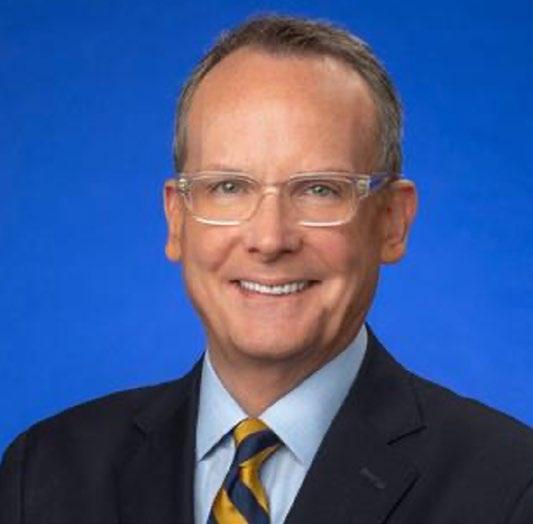
E.W. Scripps Co.
E.W. Scripps Co. has promoted Jeff Kiernan to the new role of VP of local news. He will oversee Scripps’ local news content strategy alongside Kate O’Brian, Scripps’ president of news. Kiernan previously served as VP/GM for KTNV, Scripps’ ABC affiliate and KMCC, Scripps’ independent station, both in Las Vegas, since 2022. He has spent much of his career leading local newsrooms, including Scripps’ WXYZ and WMYD in Detroit and WTMJ in Milwaukee.

